The 32nd Guards Air Fighter Regiment in
Cuba (1962-1963)
The chapter from Sergey Isaev's book
“Pages of History of
the 32nd Guards Vilensky Air Fighter Regiment awarded with Lenin and Kutuzov
orders”
In February 1950 the 32nd Guards Air
Fighter Regiment (32nd GIAP) has been transferred to Kubinka AFB (60
kilometers to the west of Moscow) and was subordinated to the 9th Air
Fighter Division (9th IAD). Within 1950th years, the regiment except
routine combat training constantly participated (MiG-15/17 and MiG-19
planes) in aviation parades above Moscow. The 32nd GIAP was the first
fighter unit of the Soviet AF to be equipped with the newest MiG-21F-13
planes (NATO code MiG-21 Fishbed-C) in 1960. After that, the regiment
participated in combat trails of this fighter aircraft. On July 9th, 1961
32nd GIAP in full strength has shown for the first time its MiG-21 planes to
public during air parade over Moscow. In July 1962, the 32nd GIAP’s the
second aviation squadron on MiG-21F-13 planes under command of CO Major Yuri
Nemtsevich has been sent to Indonesia for providing military assistance to
the country. After that, flight and ground personnel from another fighter
regiment based in Belorussia has completed 32nd GIAP.
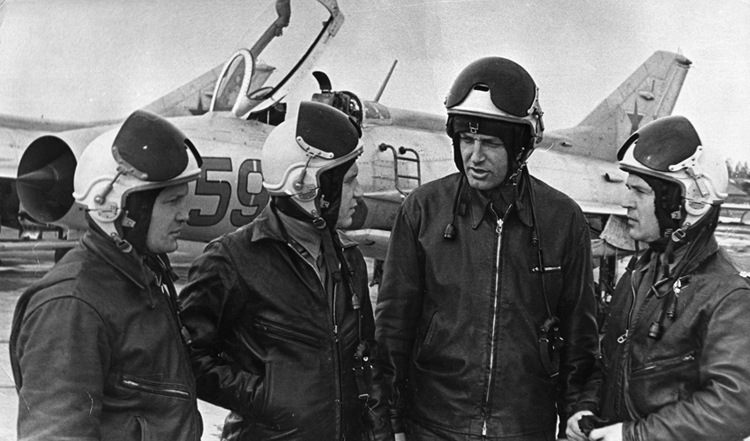
Kubinka AFB, Russia. 1961. The 32nd GIAP
pilots on a background of MiG-21F-13.
From left to right: Khramov, Sladkov, Teslenko, Mikhailov.
Alexey Mikhailov’s archive
In 1962, Colonel Nikolay Shibanov
commanded the 32nd Guards Fighter Regiment. His deputies were skilled
fighter pilots, true masters of aerobatics: head of the regiment’s political
department Lieutenant colonel Nikolay Shcherbina, Lieutenant colonel Sergey
Perovsky, Vladimir Grol and Leonid Grigoryev. Lieutenant colonel George
Ashmanov was the chief of the regiment headquarters; Lieutenant-colonel
Konstantin Zharov headed the air engineering service. First-class pilots
were commanders of the squadrons: the first one - Major Anatoly Shod, the
second one - Major Alexander Yeliseyev, the third one - originally Captain
Larionov, later - Captain Vasily Egorov. The regiment was supported by the
425th Independent Battalion of Ground Technical Maintenance under command of
Lieutenant colonel Boris Prusakov and by an Independent Battalion of Lights
and Radio Engineering Services commanded by Lieutenant colonel Krivosheev.
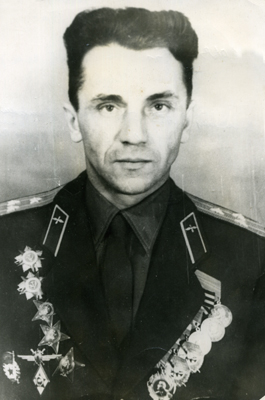
The 32nd Guards Air Fighter Regiment commander
colonel Nikolay Shibanov |
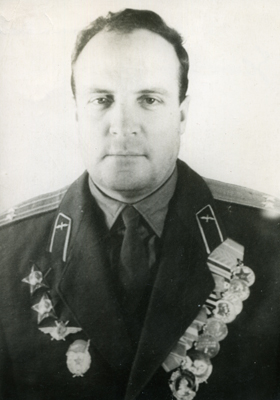
The 32nd GIAP deputy commander, head of the
political department lieutenant-colonel Nikolay Shcherbina |
| |
|
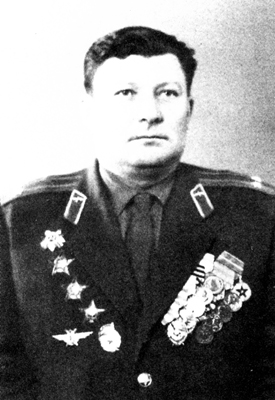
The 32nd GIAP deputy commander
lieutenant-colonel Sergey Perovsky |
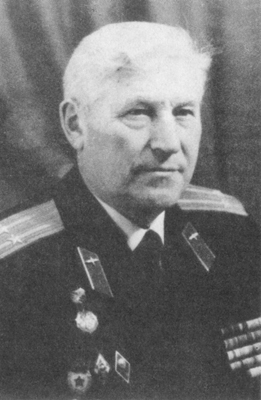
The 32nd GIAP chief of headquarters
lieutenant-colonel George Ashmanov |
PACKING STUFF
Nikolay Pakhomov: At the beginning
of July 1962, the personnel of the 32nd GIAP and supporting units had a
meeting with the commander of the Air Force of the Moscow Military District
Lieutenant-general Eugenie Gorbatyuk. He ordered the regiment to be ready to
redeploy to an airbase outside the Soviet Union to carry out there training
missions. The regiment started to execute the order. All preparations were
carried out in strict secrecy. All personnel were checked by special
authorities, underwent tough medical tests, and antiepidemic vaccination. We
were recommended to take warm clothes, high fur boots, overcoats and warm
linen in order to create, as we later understood, an effect of shift to a
northern area with low temperatures.
|
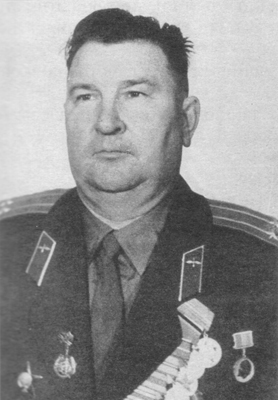
Nikolay
Pakhomov,
Lieutenant colonel, retired. In Cuba, he was Major, deputy chief
of staff of the regiment. Born in 1923. In 1942 he graduated the pilot's
school, flied I-16 and La-5 piston fighters. Served in the Far East. While
serving in the 917th IAP he fought against Japanese in 1945. In 1947 due to
health reasons, he was written off from flight practice and transferred to
staff work. From 1946 till 1955, he served in the Far East. From 1956 till
1965, he was deputy chief of staff of the 32nd GIAP, then chief of staff of
the 33rd GIAP at Wittschtok AFB, Germany. Retired in 1971, lived in Kubinka,
the Moscow area. Died in October 2005. |
Nikolay Pakhomov. Extract from
private diary:
July 13, 1962. After lunch, I got to the headquarters of the regiment. They
informed me that I immediately had to be in Moscow at the Air Force HQ of
the Moscow military district. The reason was unknown. On the airfield, an
An-2 liaison aircraft was waiting for me, as well as a car at the central
airfield in Moscow. I got to the HQ, reported my arrival. I have been called
to a room where I saw the commander General Gorbatyuk, the chief of staff
and the HQ heard of political department. How are you? - was the first
question. And what about your family? - O.K. - was my answer. - We have
decided to send you to a business trip to a hot and humid country. Any
objection? – They asked. - I had none, whatsoever. Next day I was ordered to
report again to the HQ.
July 14, at the HQ. All officers who had gathered were ordered to a bus that
carried us to a sewing workshop where we took off uniforms and footwear,
packed them all in hold alls, and marked them. We got then a civil dress.
Then we handed over all documents: IDs, party membership card, and got the
order to come back next day for instructions.
July 15. After instruction on how to behave abroad, we received foreign
currency - 15 US dollars and ordered to start our business trip next day.
July 16. In the morning, the CO of the regiment Colonel Shibanov discharged
his personal "Pobeda" ("Victory") car to take my wife, my daughters and me
to the HQ in Moscow. There I got my new documents - the passport, which said
that I was an "operator of agricultural machinery", and the travel papers to
Havana, Cuba. My wife and daughters were waiting for me outside meanwhile. I
hardly persuaded an accompanying officer to allow me to say goodbye to my
family. One minute was allowed to. I just told them that we were going to
Cuba for the time unknown. Then we were placed in a bus that brought us to
Vnukovo airport, directly to the gangway.
Before the plane took off, Raul Castro and chief of the Joint Staff of the
Soviet Armed Forces Marshal of the Soviet Union Zakharov went up aboard the
plane. Raul greeted us through the translator: "Hello, comrades, agriculture
workers". He came with us till Havana. Our Il-18 turboprop plane took off at
7.45 p.m. The first landing was in 5 hours and 20 minutes at Presvich
airfield near Glasgow (Scotland).
July 17. The second landing and we arrived to Gander airport (Canada). It
took us 6 hours and 25 minutes to fly over there. The air terminal looked
good. Beer was good.
|
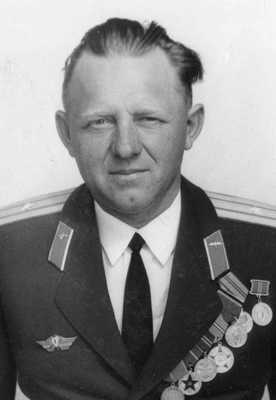
Victor Sharkov, Major, retired. When in
Cuba he was Captain, chief of group of aircraft technicians of a squadron.
Born in 1928. In 1949, he finished the aviation mechanics school. Since 1950
till May 1962, he served as aircraft technician in the 32nd GIAP. Since 1964
- deputy chief of the technical support unit of the regiment. From 1970 till
1974 - Major, chief of a technical support unit of the 787th IAP, Finnov
AFB, Germany. From 1974 till 1978 - chief of the technical support unit of
the 234th IAP the 9th IAD, Kubinka AFB. Retired in 1978, and lives in
Kubinka, the Moscow area. |
Victor Sharkov: It took us over a
month to disassemble and load our planes – combat MiG-21F-13 and two-seat
UTI MiG-15 trainers. It was really a hard month to live: detaching
fuselages, preserving engines, draining fuel from tanks, detaching planes,
placing fuselages on dummy chassis, disconnecting tail plumage, etc., and
packing all that stuff into special containers. The containers were designed
for transportation by sea, i.e. were practically tight and robust,
upholstered inside with some paper looking like parchment, in two or three
layers. It made us think that we would go long and necessarily by sea. The
containers were loaded on railway platforms. It was a round the clock job by
shifts. The workers from Gorky aircraft assembly plant that produced our
MiG-21s helped us.
Nikolay Pakhomov: The 32nd GIAP personnel
included 167 commissioned officers (57 pilots among them), 32 warrant
officers, and 212 private soldiers, was transferred to Cuba from August 2
till September 22, 1962 first by rail to Baltiysk, then by ships to the
destination points. Among the personnel sent out to Cuba there were 42
women, employees of the Soviet Army – medical staff (doctors, nurses),
clerks, cooks, and waitresses.
Victor Sharkov: Readiness for departure
was declared. However, some time before, the regiment deputy commander, the
heard of political department Lieutenant colonel Nikolay Shcherbina had
called the officers to write an official report stating their voluntary wish
to perform an important duty. Oath-bound, we were obliged to go even to hell
and gone to fulfill an order, so we did it. We were young, we trusted in the
Communist party piously, and possible consequences reminded everyone that
any defeat or failure would be punished. And here was an example, air
engineer Major Kolomiyets, a competent and dear expert, a former pilot
graduated from Zhukovsky Air Academy, refused to write the official report
due to health reasons. So he was lowered in his post as a “coward” and sent
out to serve in a distant city of Torzhok. Many people saw us off at the
time of departure: wives, children, and division top officers with General
Dubinsky at the head. Wives were crying, kissing, saying parting words and
hopes to meet us at home, but when would it happen, no one knew.
Mikhail Isaev: By the end of July all
containers and special vehicles were placed on railway platforms. I was
assigned duties of chief of the ground echelon. Only at the departure of the
railway echelon I found out the destination point - Baltiysk. The echelon
went fast, without any stops, and in a day we reached the port. We stayed
there almost a month loading the equipment, belonging to our regiment and
other units, up to ships. The ground equipment was placed in timber carrying
vessels or dry-cargo ships. The top circles of holds of dry-cargo ships were
equipped along perimeter with two-storey beds for the soldiers to sleep.
Field kitchens were then arranged on the deck near forecastle, and the WCs
were installed on the forage. The containers with aircraft inside were
placed on the covers of holds. An Il-14 transport aircraft was not subject
to disassembly, so a dummy superstructure was built on a dry-cargo ship to
conceal it. In Baltiysk before boarding the ships, all Cuba-bound personnel
changed their uniform clothes for civilian. The officers got woolen suits,
shirts with ties, checkered shirts (cowboy type), raincoats and hats. The
warrant officers and soldiers got no ties, and they received caps instead of
hats. In Cuba, we all dressed in checkered shirts, were called "a
hundred-cell” and identified far off as "ruso compañero".
The Guards Red Banner of the 32nd GIAP
arrived on the last railway echelon from Kubinka. However, we got the order
to send the Banner and documents of the regiment back to Moscow. In
addition, the regiment was renamed into the 213th Air Fighter Regiment
(213th IAP). It is difficult to tell what purpose was for, but that renaming
delivered many troubles to us after we had returned from Cuba.
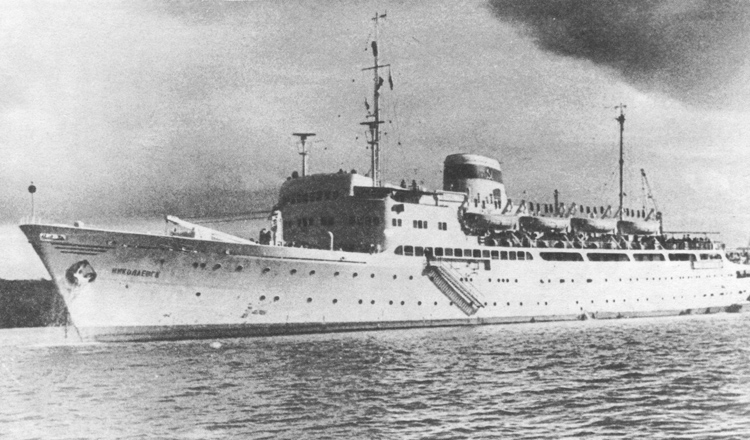
"Nikolayevsk" passenger ship
At the beginning of September 1962, we
boarded "Nikolayevsk" passenger ship registered at the Far East
Petropavlovsk-Kamchatski port. The ship was new, built in the Eastern
(socialist) Germany, and could take up to 350 passengers aboard. By that
time, "Nikolayevsk" had already made a trip to Cuba with the advance party
of our regiment. Commissioned officers and women - military servicewomen and
civilian employees of the Soviet Army, occupied all places aboard the
steam-ship. All passengers were dressed as civilian people, though each had
a complete set of the daily, the field and the so-called "Turkestan" (hot
climate) uniform. Big bosses took places in the first class cabins on the
main decks, and women were sent to the lowermost decks (“rocking was not
strong” was the explanation). And what soldiers felt placed in the holds of
cargo ships, we found out a later while coming back home in the holds of a
dry-cargo ship.
|
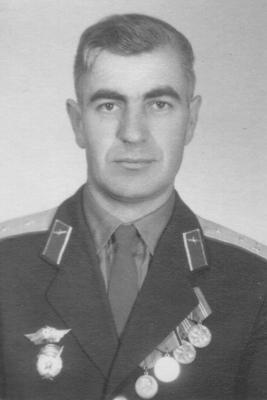
Mikhail Isaev, Major, retired. When in
Cuba he was Captain, chief of a technical support group. Born in 1930. In
1952, he finished the military air technical school. He began his service in
a fighter regiment of the Group of the Soviet Armed Forces in Germany. From
1958 till 1969, he served in the 32nd GIAP: a technician of an air flight,
chief of radio maintenance group of the regiment’s technical support unit, a
radio engineer of the regiment. From 1969 till 1974, he served as engineer
of the regiment in the 515th IAP of the Soviet Southern Group of Armed
Forces (Hungary), then at the Borisoglebsk military pilot’s school. Retired
in 1977, and lived in the city of Lobnya of the Moscow area. Died in October
2007. |
Victor Sharkov: We arrived in Baltiysk by
a passenger train, and then some days were waiting for our echelon with the
planes and equipment, which arrived on August 14. "Volgoles" timber carrying
vessel was assigned to carry the equipment – it was 124-meter long and 16.5
meter wide. Its loading went on round the clock, with 2 to 3 hours to sleep.
At the beginning, we filled in the bottom part of the bow holds with
vehicles, and the fodder hold with ammunition. The bow part of the deck was
charged with oil and gas, about 400 pieces of cargo overall. Several
containers carrying air equipment, and to containers with MiG-15 aircraft
were pulled down to the bottom of the holds.
Containers with combat aircraft were very
long to be placed in the hold. It took us a day to decide where containers
with MiG-21 aircraft could be put. As a result, it was decided to place 16
containers, i.e. 16 MiG-21F-13 planes, atop the covers of the holds, 4
pieces upon each. Another problem came to light: the containers had in the
case the support for only two thirds of their length. Therefore, wooden legs
were to be made to balance the containers. All this stuff was fixed with 6
mm wire to the deck and every possible part that could hold them tight. The
captain and his senior assistant looked skeptically at our efforts and
muttered that in a good storm all the structure would go to the sea within
one or two hours. The aircraft of our regiment were boarded on two ships:
"Volgoles" timber carrying vessel and "Divnogorsk" dry-cargo ship.
On July 17 32 pilots and we (4
technicians) were lined up on the upper deck of the ship. The Admiral heard
the report, gave out instructions and checked the staff. All of a sudden, we
missed two pilots – first lieutenant Beloborodov and first lieutenant
Olkhovik. We rushed to find them. In a while, they appeared singing and
smiling, since both had taken a considerable amount of alcohol “load” before
departure. These officers were discussed at the party meeting that was held
immediately. Beloborodov, a high, good-natured and phlegmatic guy, knelt
down at the meeting and said: “I am a Soviet citizen, and I will die for my
Native land, redeem my offence with my blood, just do not leave me ashore”.
He was forgiven, and he turned out a very good pilot. Another pilot was
expelled from the Communist Party, sent back to Kubinka air base where he
was dismissed from the Soviet Army without pension.
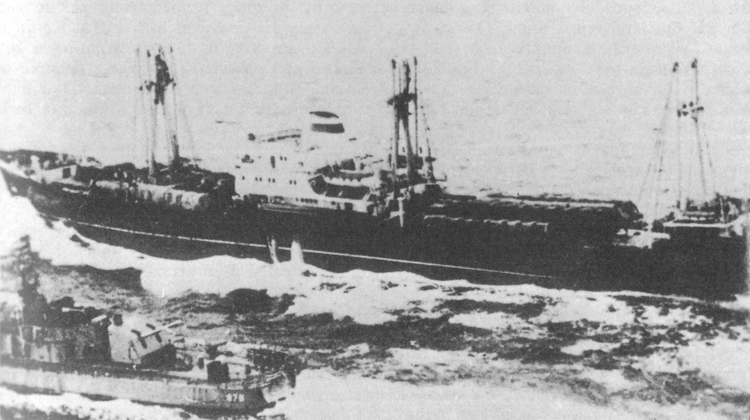
"Volgoles" timber carrying ship transporting
the Soviet ballistic missiles on the main deck on return
trip to Russia
was escorting by a US destroyer. The Caribbean sea, November
1962
We were placed aboard "Volgoles" ship as
follows: the pilots were placed in the cabins together with the team of the
ship, one cabin for two pilots. And we, four technicians were put a
bunkroom. The bunkroom was located in the bow part of the ship; therefore, I
was assigned the mission to watch the fastening condition of containers.
EN ROUTE
Victor Sharkov. Extract from private
diary:
August 17, 1962, at 8 p.m. two tows moved "Volgoles" ship out of the port.
The steamship gave a farewell lingering hooter. Sailing, we felt sad and
somewhat uncertain. What would our future look like?
August 19. The air was grey and cold, we were passing the Northern Sea. In
the strong fog, we reduced our speed.
August 20. Meal was arranged well, four times a day: at 8.30 a.m., 12.30
p.m., 6.30 p.m., and at 9.30 p.m. Meal was very good, and we felt as if we
were having a rest at some fashionable resort area with quiet hour sleeping,
reading, sunbathing, playing chess. Lighthouses on the coasts of England and
France were passing away. We got closer to England; its cities on the coast
were well visible.
August 21. By the evening, we rounded the Brittany peninsula, and went
southwestward. Next morning the sea was restless. It was stormy, up to six
points in strength. The Bay of Biscay, it was impressionable, we felt
miserable, rolling repeatedly in beds.
August 23. The ocean was very friendly. From 8.00 a.m. till 12.00 p.m. I was
watching forward from a navigational officer platform. Except for unlimited
ocean, I noticed a group of dolphins, a wooden flank swinging in the water,
and a seagull flying from the West. On watching duty we served by shift. It
is a good cure against idleness.
August 25. The ocean was quiet. The day was sunny and bright. I asked our
radio operator whether a short message could be sent out to families, and
got the negative answer. Only reception of messages was allowed.
August 28. “The ocean protects us”. The involuntary phrase heard on the
deck. Really so, with all that cargo, and on the open deck!
August 31. The night was stuffy, hot. The ocean was quiet. Many ships and
birds in sight. Seemingly, we were approaching the land. We will reach
Bahamas at night. Tomorrow a deciding stage will come. Can we break through
the American barrier, will we be safe? We hope that submarines accompany us.
We heard that that Americans had blocked Cuba.
September 1. We have reached Cuba at last. Within 15 days. I was on forward
looking duty from 8.00 a.m. At 6.10 p.m., we got a pilot aboard, and for
about an hour, we were sailing through a narrow channel to the bay of
Nuevitas. Anchored. Nobody was waiting for us here. A boat has approached,
and they found out long who we were and what we arrived for. Waiting for the
morning to come.
September 2. It turned out that we got to the wrong port. Anchors up, we
turned around and started for the bay of La-Isabella. The sailing took 15
hours; then again, we were waiting for a pilot. A hard day, humid and
cloudy, miserable headache. The uttermost apathy.
September 3. At 2.00 p.m., we anchored at a mooring. In an hour, we went
ashore to knead muscles. We feel as if the earth is trembling under our
foots.
September 4 to 6. We were waiting to launch the unloading. However, there is
no crane capable to move containers up from the deck to the mooring.
"Divnogorsk" ship has arrived. Korolev, my flat mate, has delivered a letter
from my wife, very much delighted. I reread it several times, and felt as if
I visited my home.
September 7. The floating crane, designs of times of the first steam
machines and steam locomotives has come. It was a mixture of a steam
machine, a puffer, and a thick hempen rope. A young Negro operated the
crane.
On September 8-12. The unloading of containers from the holds was a very
hard job to do. Retaining the containers semi-vertically, we had to move
them through the small mouth of the holds, manipulating the cables
simultaneously. It was hard to observe the unloading of the ammunition from
the fodder hold. With heat and awful humidity in the holds, all boxes were
taken out manually to fill up the bag boom.
Mikhail Isaev: On September 8, 1962,
"Nikolaevsk" passenger ship sailed from Baltiysk. The route to Cuba we had
to pass had been already mastered. The navigation through the Atlantic Ocean
turned out smooth as a whole. Being lucky, we reached Cuba with no strong
storm on the way behind. About three days before our arrival to Cuba, a
number of American aircraft began flying over our ship. US Lockheed P-2
Neptune patrol aircraft were in the sky above us often, extremely low, near
the masts. Faces of pilots, their white-toothed smiles were distinguished by
naked eyes. When the aircraft appeared, loud speakers announced: “First
class passengers and women must go to the deck”. In reply to the Americans’
smiles, our women waved hands.
September 22, two weeks after departure
from Baltiysk, "Nikolaevsk" moored to a pier of La-Isabella port, which
struck us with its poor view. It looked like a small fishing village, not
like a port, whatsoever. As soon as we moored, an order was announced: “No
one may leave the ship for the shore!” A representative of the Soviet
military command came aboard the ship. All "passengers" were gathered for
instructions. The representative drew a picture of “the political moment”
and said: “Comrades, you are here not military servicemen; you are
agricultural workers, tractor operators, agriculturists, in no way you here
belong to the military service. Remember it!” Therefore, we have turned to
"tractor operators".
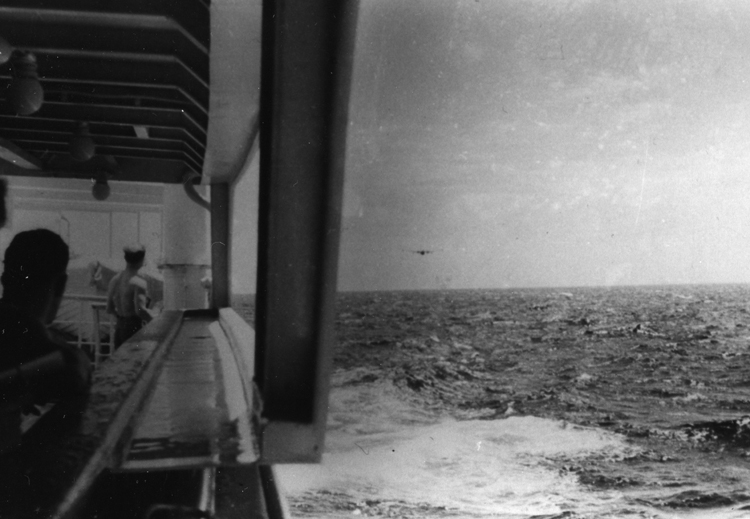
US patrol plane Р-2 “Neptune” was approaching
"Nikolayevsk" ship.
The Caribbean sea, September 1962. Photo by Mikhail Isaev
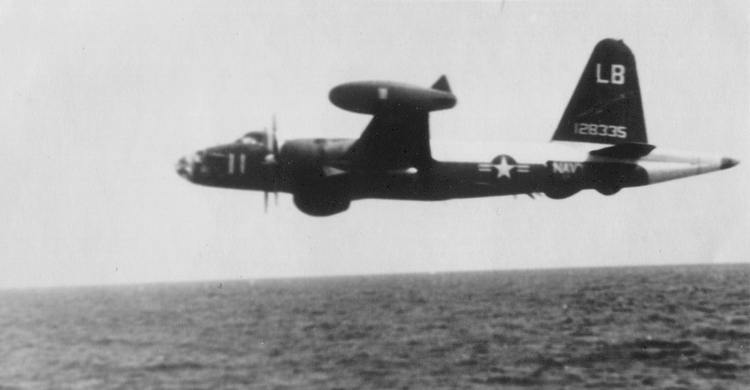
US patrol plane Р-2 “Neptune”. Photo made by
Evgueny Vladimirov from deck of “Volgoles” ship.
Caribbean sea, September, 1963
IN CUBA
In July - September 1962 a
40,000-men-strong grouping of the Soviet Armed Forces was thrown off in a
secretive and stealthy manner from their home base to play their role in the
strategic operation named “Anadyr” . The Group of Soviet Armed Forces in
Cuba headed by Army General Issa Pliev, a former cavalryman, was formed
around the 51st Missile Division of the Strategic Missile Forces – three
R-12 missile regiments and one R-14 missile regiment which were armed with
ballistic missiles (the range of R-12 - 2000 km, that of R-14 - 4500 km).
The Soviet Armed Forces in Cuba also included a Coastal Missile Regiment
(armed with "Sopka" ground-to-sea system), a Front-wide Cruise Missiles
Regiment (FKR-1 ground-to-ship missiles), a Missile Air Defense Division
(equipped with S-75 complex ground-to-air missile), maintenance-and-support
units. The ballistic missiles launching sites were guarded against
amphibious attacks by four independent motorized infantry regiments.
The Soviet air force grouping in Cuba
consisted of:
• 759th Independent Red Banner Tallinn Air Torpedo-bomber Regiment awarded
with the Ushakov and Nakhimov orders (commanding officer Colonel Dmitry
Ermakov) equipped with Il-28 "Beagle" medium bombers and subordinated to the
Group's Navy command;
• 32nd Guards Vilensky Air Fighter Regiment awarded with Lenin and Kutuzov
orders (commanding officer Colonel Nickolay Shibanov) equipped with
MiG-21F-13 “Fishbed” fighters, subordinated to the Group's Air defense
command;
• 437th Independent Helicopter Air Regiment (commanding Colonel Vladimir
Lyalinsky) equipped with Mi-4 and Mi-6 helicopters subordinated to the
Group’s Air Force command;
• 134th Independent Air Transport Squadron equipped with Il-14 and An-2
transport aircraft, subordinated to the Group’s Air Force command.
The data on actual presence in 1962 in Cuba of an independent air bomber
squadron equipped with Il-28 aircraft, carriers of nuclear weapons turned
out impossible to be found in the media.
Due to the big extent of areas of
prospective operations, the Soviet air defense missile battalions (S-75
ground-to-air complex, known in the West as SA-2 Guideline) were placed 60
to 80 kilometers away from each other that did not allow covering the entire
space above Cuba. Therefore, the Soviet command planned to employ the 32nd
GIAP and the Cuban Air Force fighters (MiG-17, MiG-19) to control air space
between the zones that were covered by the SA missile units. The 32nd GIAP
was located in the center of the island at the Santa Clara AFB and could
operate in both the westward and the eastward directions. The Soviet fighter
regiment was supposed to concentrate its main efforts along the Havana
direction and along the most assault-dangerous sites of the northern coast,
from Varadero up to Cabañas. Besides, the 32nd GIAP was supposed to operate
against sea assault landings in the southwest of the island and in the area
of the Isle of Pines. The Navy's 759th Independent Air Torpedo-bomber
Regiment was assigned the destruction of hostile combat ships and landing
means in case of danger of intrusions. The helicopter regiment was planned
for the purpose of transportation of cargo and wounded personnel,
reconnaissance of the coastal strip, and to carry combat units to the
dangerous areas.
Nikolay Pakhomov. Extract from private
diary:
On July 17, 1962. We arrived to the airport of Havana. It took us 7 hours
and 10 minutes to fly here from Gander airport. They met us well.
July 18. All the day we were preparing for tomorrow's trip. The sunny day in
Cuba turned into an evening strong rain and a thunderstorm.
July 19. Captain Curbelo, Air Force & Air Defense commander of Cuba Armed
Forces came in the morning to take us. Il-14 aircraft brought us from the
airport of Havana to the east provinces. The first stop was the airport of
Santa Clara. Chief of the air base treated us with a dinner. After that, we
went on to Camagüe. The air base here was looking better than in Santa
Clara. The seaport looked like in Santa Clara. Back to Havana. Captain
Curbelo organized a good dinner with cold Czech beer. We spent the night in
an excellent house with a shower and a water pool.
July 20. In the morning, after breakfast we took off for the air station of
Holguin, which was under construction.
July 22, Sunday. After dinner, we went to a beach but could not swim for the
lack of swimming trunks. Therefore, we went out for a tour over Havana. A
big city with narrow streets, and soft drinks offered at each corner.
July 24. We are at the “uno” point, i.e. the first, still. We try to do
whatever each can - sleeping, reading. It is hot and very humid.
July 25. In the morning, we played cards, as usual. We went to Havana to
participate in an evening party devoted to the Day of July 26 – the
anniversary of the beginning of the revolution. An official part was
translated into Russian. Then a concert, dances, cold beer.
July 26 till August 1. Every day begins and comes to end in the familiar way
– we play cards. On July 26, the Soviet embassy first secretary arrived in
the evening to give us a lecture about Cuba. Strong heat, raining almost
every day with a thunderstorm.
August 1. In the morning, we went out to examine the ways our cargo will be
moved along: roads, bridges, crossings. They informed me that our
disposition has not been determined yet.
August 4. It seems the disposition area has been determined. By the words of
the Soviet air force Lieutenant General Stepan Grechko, deputy commander of
the Group of the Soviet Armed Forces in Cuba for air defense, it was Santa
Clara.
August 5. An unpleasant message arrived in the morning: one person was dead
and three persons were wounded in an accident. We tried very long to find
out who were those dead and wounded, since neither the victims nor the rest
of our people had any documents (ID). Then came an order to buy notebooks
and to write down there surnames, names and middle names, as well as names
of close relatives (wife, father, mother) and their addresses. These were
our passports to have abroad.
August 8. All the Soviet officers were gathered for a meeting in the
evening. Fidel Castro delivered a speech for 1 hour and 20 minutes about the
political situation in Latin America, and in Cuba, and the reasons to bring
the Soviet forces in.
August 11. The destination points our ships had to reach had been changed.
Got an order to be ready to fly off to Santa Clara. Got information about
the Soviet cosmonauts Nikolaev (#3) and Popovich (#4) launched into the
outer space.
August 13. On board Il-14 transport plane, we have arrived to Santa Clara as
a permanent station. Comandante Juan Almeida, the commander of the Cuban
Central defense zone, took into account the accommodation of pilots only.
When we informed about the total number of the personnel, Almeida clutched
his head and got no idea what to do. Afterwards Grechko and Almeida left for
Camaguey. We left by a vehicle for the port of La Isabella: the port looked
good and the roads too.
August 15. In the morning, Almeida did not deliver anything new on our
accommodation. He could not help us with accommodation facilities, since he
found only another house to settle down 10 persons.
August 16. Called to Havana. Our ships are late. We have nothing at our
disposal to meet them. It is raining day and night.
August 19. Today the forward group of the 425th Independent Battalion of
Ground Technical Maintenance arrived. They were placed under tents. It was
raining permanently; therefore, to live under tents was hardly comfortable.
We searched the city for vacant houses; the Cubans did not want to do
anything of the kind. Some houses demanded repair.
August 22. At last, I met in the airport Colonel Nikolay Shibanov, commander
of the regiment.
August 23. Shibanov and I examined our possessions, no good. Running out of
foodstuff. One meal was that day.
August 24. Shibanov and I left for Havana to meet general Grechko. Having
listened to us, promised nothing, since he had nothing to. On the way back
we made a stop at Litonar (headquarters of the Soviet missile division). Had
supper.
August 25. We visited Almeida’s headquarters. Talked much, asked to help
with accommodation. A lot of promising, but doing nothing. Everyone would
request Havana. Since that moment, our commander Nikolay Shibanov took the
entire burden on his shoulders.
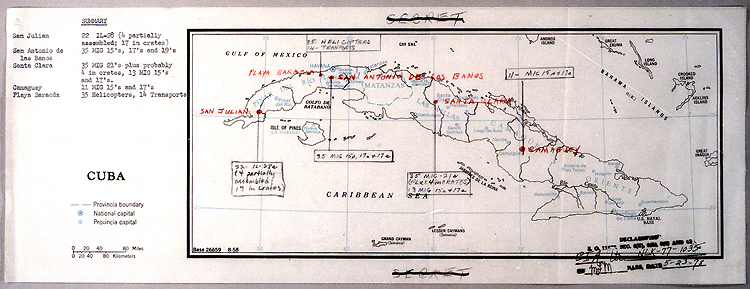
The map of Cuba from the CIA report indicated
grouping of the Soviet and Cuban Air Forces.
October 17, 1962. The John F. Kennedy Presidential Library
and Museum
Nikolay Pakhomov: Santa Clara AFB located
5 km to the north-west of the city of Santa Clara was assigned to settle
down our regiment in Cuba. The AFB had an excellent runway of 2500 m x 47 m
with asphalt concrete covering, taxi lanes, parking spaces and equipped with
OSP-48 system of blind landing. In Cuba, our regiment was renamed as the
213th IAP and became part of the AD division.
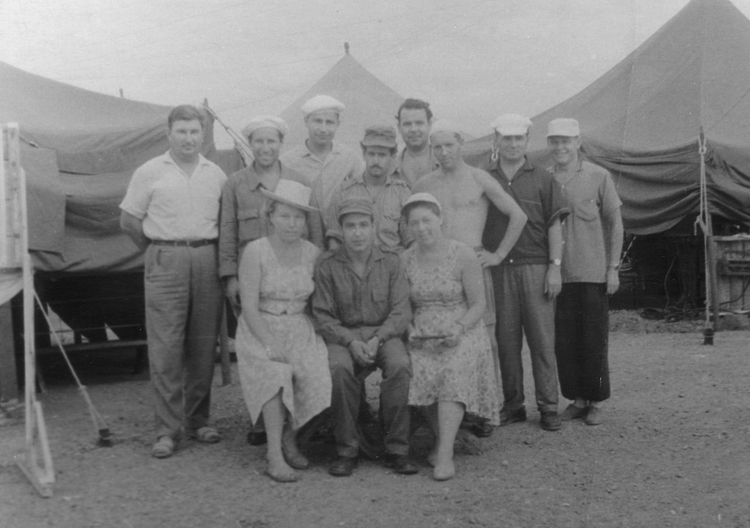
The regiment HQ. The first at the left –
Nikolay Pakhomov.
Cuba, Santa-Clara AFB, October 1962. Nikolay Pakhomov’s
archive
As the personnel of the regiment were
arriving to Santa Clara, the accommodation issue got hot. Decided to settle
the under tents, considering it traditionally normal. However, in Cuba it
appeared the hardest test to undergo. Almost daily tropical rains,
accompanied with continuous lightning and thunder, filled in the territory
of the garrison with water within minutes. Our suitcases were floating under
tents; the ground - red earth turned immediately viscous dirty one could
hardly pull foots out. Some time later, the clouds would disappear and the
sun high above our heads would go on baking with initial force. Heat again,
all soared, and to remain under tents, with the cloth lifted, was just
impossible. And mosquitoes and other moths drove us mad at night. We could
sleep under mosquito nets made of several layers of gauze.
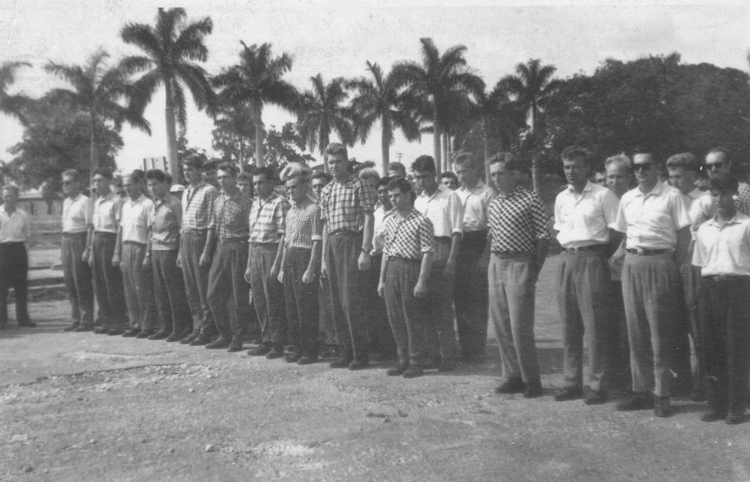
The 32nd GIAP staff. Cuba, 1962. Nikolay
Pakhomov’s archive
Victor Sharkov: When we arrived to the air
base, a tent camp had been established over there, though the place was no
good. First, it was located near the runway - 600 to 800 meters away.
Second, in a hollow that guaranteed dampness, there were mosquitoes and
every possible moth available. In the strong rain, the water could reach our
knees under tents.
Initially, Cuban drivers hauled the
aircraft containers only in nighttime. One truck (trailer) carried one
container; two the Soviet officers seated in the cabin have accompanied the
cargo. The first haulage of containers resulted in troubles. On the way
through towns, a container broke off a street electric cable hanging low.
Much noise and righteous indignation of the local people. It was decided to
haul them in the afternoon, lifting the wires by a barling and placing them
on the board lying along the container. The wires were sliding along the
board and remained unbroken. So the conflict was thus settled. On September
12, we reached the Santa Clara AFB. The containers were distributed among
squadrons located along the taxi lane.
Mikhail Isaev: The containers were placed
at the air base on special platforms. Seeing the big boxes, the Cuban
comrades we were earlier presented to as "tractor operators", asked: "What
is it?" And we answered vigorously - tractors. But when we opened the front
and back covers of the first container and rolled out a fuselage and wings
of MiG-21 aircraft, the surprise of the Cuban people had no limit. You call
it a tractor? - They exclaimed temperamentally.
Valentina Fedotova, a nurse: The female
personnel were also placed under tents. Hot, stuffy, especially in the
rains. Malicious "enemy" were insects of any sort known, flying over and
creeping. Some of them were not only stinging painfully but also poisonous.
Due to stings, many women felt bad, and needed medical aid. However, men
suffered much from insects too. The climate generated an artful and
wearisome illness - dysentery. Many military men and employees went through
the treatment in a hospital and sanitary points of combat units. I was not
an exception.
Victor Sharkov: As soon as the containers
arrived, we started assembling the aircraft. The most labor-consuming job
was unpacking containers. They were heated inside up to 60°C, the
temperature was intolerable, stuffy, no air to breathe. We felt a
suffocating oil smell floating from the heated parchment paper covering.
Under the conditions, we pulled out boxes
with demountable equipment, a 500 liter dropped fuel tank, blocks of UB-16
unguided rockets, starting devices, removed all fastenings from a fuselage,
planes and the stabilizer, rolled out a fuselage and, at last, took out two
planes weighing over a ton by hands. For this purpose, we concentrated all
our force, endurance, and management capabilities. When it was very hot, a
watering vehicle came over to provide us with shower before and after
dinner. Refreshed, we worked cheerfully. At first, our technical staff was
engaged in assembling the aircraft, but the time ran short, and the
personnel available did not suffice, as part of staff still was on the way.
I asked Major Shtoda, CO of my squadron, to help us with the unloading. He
agreed willingly, and the next day the pilots arrived to give us helping
hands. The pilots unloaded ten containers that helped us a lot.
Nikolay Pakhomov: With the arrival of the
main force of the regiment, we hastily started to build wooden barns through
an arrangement with the Cuban command of the air base. The regiment HQ
staff, the maintenance battalion and the main part of the personnel were
settled down in the barns and the aircraft containers. No convenience to
live in. The pilots and the commanding officers of the regiment were
accommodated better; several houses (we called them "villas") were assigned
to them in city. The tents and caponiers accommodated a dining room, a bath,
a sanitary unit, a number of warehouses for spare parts, foodstuff and other
properties.
Victor Sharkov: When we assembled planes
and started to test them in all modes, the first start of an engine was not
a success; the attempts to start it resulted in ignition of the fuel left
inside. We resorted to fire extinguishers. The reason was defined fast. It
turned out that due to high temperatures and humidity, the starters of
engines were misadjusted. Preliminary readjustment of each starter helped a
lot. However, our troubles did not go away. We found out a mass defect -
leak of fuel from the tanks. The tanks when transported were empty, and fine
cracks occurred in the folds of the rubberized fabrics. We had to get new
tanks from the Soviet Union by air, and immediately.
Nikolay Pakhomov: Despite of the
difficulties, the first combat aircraft have been assembled and tested on
the ground. Another problem became known. The pilots had an inadmissible
break in flights, they had to start flying and the regiment had to take up
the combat duty urgently. The USAF planes appeared above our air base daily
on a regular basis. They were a pair of McDonnell F-101 Voodoo aircraft,
with the USAF identification, the leading was a two seat "photographer" and
the single seat was conducted airplane, flew over above our air base,
increased their speed and left off leaving a black smoky loop behind. And we
were powerless to do something.
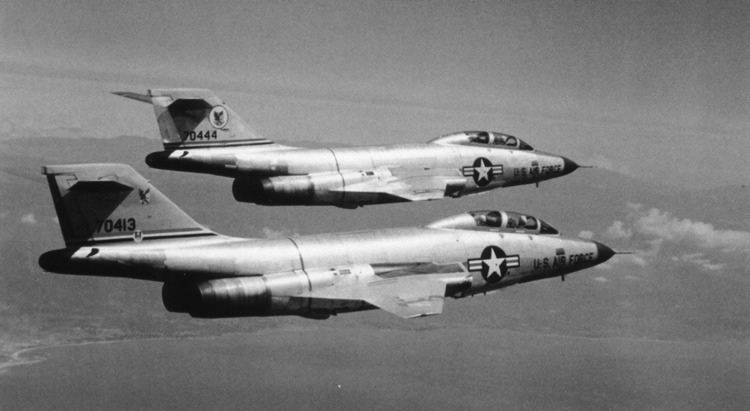
USAF McDonnell F-101B Voodoo fighters in
flight
CO Colonel Shibanov took a courageous and
risky, but the only right decision - to start flights. Lieutenant-colonel
Vladimir Grol, the senior navigator of the regiment, took off aboard the
first MiG-21 aircraft on September 18, 1962, made several circles, then left
the limits of our air base, then went low above the runway. That was the
necessary beginning. Everyone who observed this important flight, felt
pleasure and pride of the first real success. The commanding officers of the
regiment and the squadrons started and then all other pilots took off the
next days. All pilots became combat ready. By the end of September 1962, 40
combat MiG-21F-13 and 6 trainers UTI MiG-15 aircraft were assembled tested
in the air. The regiment in full strength began to pursue the scheme combat
training and started performance of battle watch day and night.
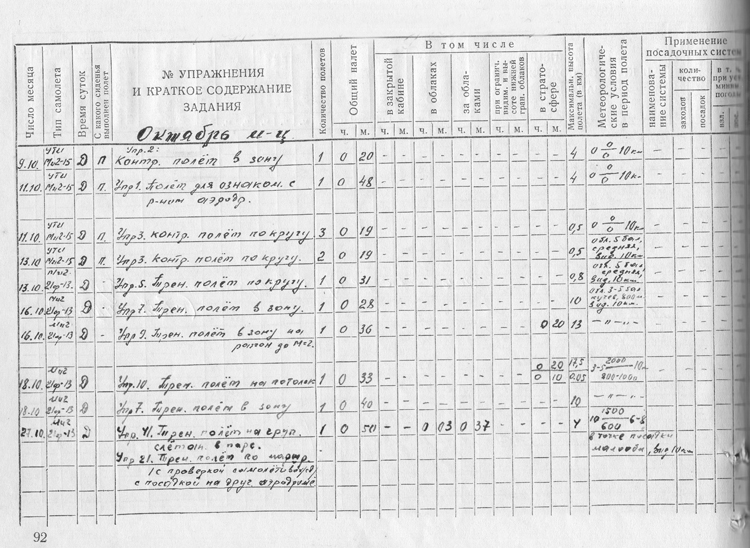
Page “October, 1962” from Dmitry Bobrov’s the
Pilot book
|
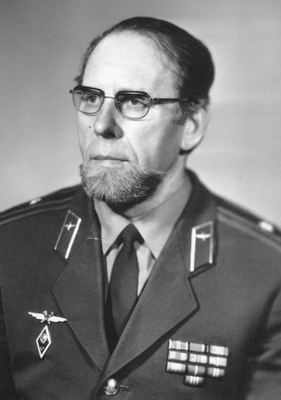
Eugenie Vladimirov, Major, retired. In
Cuba, he was Captain, a navigator of command post of the regiment. Born in
1928. In 1950, he finished the military aviation school of navigators. In
1950 till 1953 served as navigator of Pe-2 front bomber. Then, due to health
reasons, he was written off from flying missions and continued his service
as navigator-operator of a ground command post. Upon returning from Cuba, he
served as a radio engineer, a teacher at the educational center of the
Soviet Air Force training foreign experts to repair aircraft equipment. Has
retired in 1974, and now lives in the city of Lyubertsy, the Moscow area.
|
Eugenie Vladimirov: The paramount task
upon the arrival to Cuba was to assembly the aircraft, which was fulfilled
by the technical personnel of the regiment. The pilots and the command post
officers of the regiment started studying Spanish, since the radio traffic
during flights was maintained in Spanish only. A phrase book was urgently
developed to carry the most common commands in Spanish: permit to start
engines, to run from the parking space, to run to the runway, to take off,
etc. Also to intercept a target: course of flight, height, speed, a turn
with the certain roll, target orientation, etc.
The command post (CP) of the regiment
consisting of four navigators and several chart board readers, soldiers,
were directly submitted to chief of staff and carried out a daily combat
duty, and during flights, they assisted commander of the regiment and head
of flights to maintain control over the aircraft flying along their route or
leaving to intercept air targets. CP officer on duty - a navigator – was
obliged to keep up the aircraft that were flying along the route, in flight
mastering zones, and intercepting air targets, to tape the radio traffic
between the pilot on an interception mission, on one side, and head of
flights and CP officers, on the other side.
Vladimir Vasilyev, While in Cuba, Captain,
flight commander: My flight time in Cuba made up 62 hours, day and night. I
stored deep in my mind one mission, which put an end to a riddle concerning
the use of concrete plates that covered the decks of "Volgoles" ship that
carried us to Cuba. Commander of a squadron planned a mission for me and
Captain Markov to take pictures of the launching site. Our aircraft were
equipped with photo cameras. Experts charged the camera of captain Markov’s
aircraft, and my role was to take care of him. Therefore, we took off,
reached the planned area, and against a background of the red earth we saw a
flooring made of pentagonal plates, surrounded with palm trees and looking
like that we had walked up and down while aboard "Volgoles" ship. This was
the launching site. Here was the end to the riddle. Markov began taking
pictures, and I left upwards to observe his work and the space around. All
was quiet. The work was over. We had no idea as to whom the film was sent
to, but the CO said: “Well done”.
Those who flied above Cuba knew that its
sky was impossible to forget. One rises up in the sky, and almost all island
lies in front. At night at some distance away, there is the glow of lights,
it is Florida, and around you to the north and the south there is the
infinite blackness - the sea. A beautiful view!
Mikhail Isaev: The fulfillment of combat
tasks was accompanied by attempts to solve our household problems. First, it
was the problem of meals. We brought from Kubinka all foodstuffs to be used
by our field kitchens. In the tropic environment it got spoiled quickly, and
beyond use were not only macaroni and groats, but also canned food. Groups
of soldiers were assigned to sort out the groats and macaroni. However,
despite the shrewdness of our quartermasters, we found worms in our food
sometimes. Fresh vegetables and fruits were not delivered to us.
Nikolay Pakhomov: At the end of August,
fresh beef visited our dining room. It so happened that a soldier on duty
observing the parked aircraft at night heard that somebody was approaching
his post from the bog. He acted as he had been taught and shouted out:
“Freeze! Who are you? Freeze! I will shoot!” and made a shot in the air. But
that someone moved on, then the soldier made a single shot the way he heard
the sound from, and something fell down in the bog. When duty officers (a
Russian and a Cuban) came up to the place of the incident, they found out a
killed cow, the bullet hit the forehead.
In the morning, the regiment CO reported
to the Cuban headquarters about the incident. The Cuban commanders were
surprised at the soldier who could get the cow precisely in the head with
one shot at night. As to the animal, they recommended to “get the cow to
your boiler”. Since it was shot down in the restricted zone, the owner had
no right to make a claim, whatsoever. By the way, there were no claims. Our
meals were cooked for several days from fresh meat.
Mikhail Isaev: Another problem remained –
no communication with our families, our homes. We could only guess how our
families lived in Kubinka. Once, at the end of November, the Group commander
four-star general Pliev arrived to inspect our regiment. After the front
review, Pliev traditionally asked: “Are there any questions, complaints,
inquiries?” A young second lieutenant took courage and asked when we can
expect messages from the Soviet Union since he was worried about his sick
mother and the bride. As answer, we heard a long and angry tirade that some
"sons of a bitch" were dreaming of bride’s skirt instead of the service.
Only at the beginning of December 1962 (i.e. in 3 months after our arrival
to the island), first messages from our homes reached us. Our wives informed
that they had already known about the arrival of the regiment to the
destination point from the Voice of America radio broadcasting in Russian.
The Voice informed that the Soviet air fighting regiment under command of
colonel Shibanov and commissioner Shcherbina arrived in Cuba.
Rauf Minullin, while in Cuba, Captain, the
2nd squadron pilot: We unloaded our stuff, assembled the aircraft, studied
maps and weather conditions, and started to fly. MiG-21 is a fine and a
reliable machine – the trouble-free engine, easy control. They were really
good in Cuba. To fly there was somewhat unusual - the sea was all around.
The island is small, and the distance of 100-120 kilometers is like a
matchbox for our MiG-21 to cover. Patrolled usually in pairs. Average flight
time was about an hour.
We tried to communicate in the air in
Spanish. There was a piece of paper with the most common air commands and
phrases attached to the sight: “Allow take off, landing”, “Task fulfilled”,
“Release chassis”. Learnt them step by step. And once the control gear
failed to operate. I tried to explain in Spanish what was wrong. The flights
controller cursed me all over: what were you muttering there? Speak Russian!
And my patrolling route went in one place above a crocodile nursery. We
always flew above it. If one drops down there – then in no time gobbled up!
We met the Americans in the air, met, but
never made a shot. They did not make any provocations. All understood
perfectly well, what it smelled. We knew all about the American aircraft -
specifications, their numbers and the base. I think that our aircraft were
identical. Moreover, I did not consider them our enemies.
Nikolay Pakhomov: Our pilots, other air
experts studied area maps and Spanish to a certain degree to perform the
plan of combat training and duty day and night. Our pilots worked hard, and
they mastered soon the necessary colloquial minimum of the language. The
staff of the regiment developed documents for combat activity to come, in
particular: an operation plan in view of break in sorties; the combat alert
plan; the plan of defense of Santa Clara air base in interaction with the
Cuban ground forces in case of foreign intervention, and other documents.
As deputy chief of staff of the regiment,
I had to organize interaction with the Cuban staff of the air base with
Ernesto Yanis at the head, an extremely intelligent and disciplined officer
who knew Russian pretty good. The latter feature allowed him to be a good
translator and assistant. In cooperation, we developed a plan of ground
defense of the AFB, defined defensive boundaries at distant and near
approaches. The Cubans had to defend distant boundaries. However, they only
marked them. The Cuban commanders considered that entrenchments, trenches,
would be made later, in case of a direct threat. Our concepts considered
such an attitude frivolous at least.
The direct defense of the air base was
assigned to the technical ground personnel of the regiment; the sectors were
allocated in view of aircraft parking places. The control of defense was
assigned to the engineers of squadrons and technicians of flights. In
addition, the plan of interaction of the regiment with the AD units was
developed. It defined zones of operations, sectors, heights and signals of
interaction.
On October 22, 1962, the US President John
Kennedy announced in his Address to the nation that the Soviet medium-range
missiles had been detected in Cuba. He demanded from the USSR to remove the
missiles and declared a "strict quarantine" on all offensive military
equipment under shipment to Cuba. John Kennedy announced: "It shall be the
policy of this nation to regard any nuclear missile launched from Cuba as an
attack by the Soviet Union on the United States, requiring a full
retaliatory response upon the Soviet Union." The crisis was building up.
Next day after the statement made by the US President, the Soviet leader
Nikita Khrushchev sent John Kennedy a letter proving the legality of the
measures taken by the two sovereign states – the USSR and Cuba, which were
compelled to take measures to provide for the safety of Cuba in reply to the
US “barefaced aggressive” actions.
Eugenie Vladimirov: On October 22, in the
morning I took over duty. The command came to switch on our surveillance
radar and to work outward. Until that day, only the Cuban radars had worked
outward, and our radars had just received signals. Transmission was
forbidden. As soon as we switched on our radar stations, I saw on the P-35
radar station monitor tens of air targets flying in the northern hemisphere
near the peninsula of Florida and along the east coast of the Northern
America. By the end of October, we observed on the radar monitor every
morning an air target moving from the western part of Cuba, the Cuban AD
station tracked it. The air target passed over Santa Clara AFB at
approximately 10.00 a.m. at a height of 20 to 22 km at a speed of 800
km/hour. We knew that the plane was US Lockheed U-2 strategic reconnaissance
aircraft.
Nikolay Pakhomov: On October 22, the USA
declared the full sea blockade of Cuba. The Cuban and Soviet forces on the
island, including our regiment and service units, were alarmed. We dispersed
quickly our aircraft and vehicles along the border of the air base,
disguised them with nets and other improvised means. The staff started
digging entrenchments.
On October 24, the order arrived to
disperse the 32nd GIAP’s squadron. Lieutenant-colonel Perovsky, the regiment
CO deputy, took off for Camague air base to solve the matter of
accommodation of the 3rd squadron. The 2nd squadron under Major Yeliseyev’s
command was moved to the San Antonio AFB, the regiment HQ and the 1st
squadron remained in Santa Clara AFB. The redeployment over the air bases
was finished by the middle of October 28. Each air squadron organized alert
combat duty teams (pilots were on duty in the cabin of the aircraft): two
MiG-21 aircraft in the daytime and one aircraft with the most skilled pilot
- at night.
|
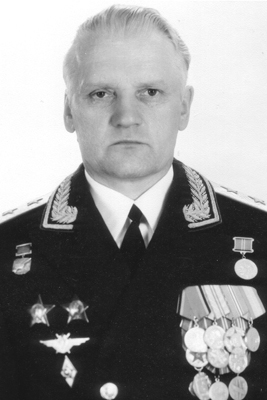
Dmitry Bobrov, Lieutenant general,
retired. During the events described, he was a major, chief of
reconnaissance of the regiment. Born in 1932. In 1953, he finished the
military aviation school of pilots. From 1954 till 1956 served in the 32nd
GIAP the 9th IAD, Kubinka AFB. Later he graduated from the Red Banner
Military Aviation Academy, command department. Continued to serve in the
32nd GIAP as commander of a flight. Since after the 32nd GIAP returned to
Kubinka, he was commander of a squadron, then deputy commander of the
regiment, commanding officer of 32nd GIAP. Under his command, the regiment
was the first in the Soviet Air Force in 1970 to fly variable-geometry wing
MiG-23 fighter. Major-general Bobrov commanded air fighter divisions in 1971
to 1975. Then he served as deputy commander of the air army. In 1979 till
1988, he was commander of the air army. He was flying jet fighters until
1981. In 1980, he became a Lieutenant general. Retired in March 1988. He is
a deserved military pilot of the USSR. Now lives in Moscow. |
Dmitry Bobrov: At the end of October 1962,
the 2nd squadron I served was moved from the Santa Clara AFB to the San
Antonio AFB near Havana. It was decided to redeploy 12 MiG-21F-13 aircraft
by three flights (4 aircraft in a flight) with suspended combat air-to-air
missiles. The regiment CO deputy lieutenant-colonel Sergey Perovsky, the
most experienced pilot, the veteran of the Great Patriotic War with the 32nd
GIAP, and participant of numerous air parades above Moscow was appointed
head of the group. During the flight en route to the combat order of our
squadron, I saw visually (about 1 to 1.5 km away) two USAF F-101 "Voodoos"
planes which were on an reconnaissance mission over Cuba, meeting no
counteraction. Perovsky reported of the US planes to the CP and requested
permission to attack them, but the CP’s reply was brief and categorical:
“Forbidden”. Therefore, it was our first meeting with the American pilots in
the air.
Since after we changed the position, the
USAF reconnaissance flights over San Antonio AFB became regular. As head of
the duty flight, I repeatedly heard reproaches of the Cuban military men who
were together with us at the TCP (take-off command post): why we do not lift
the newest MiG-21 planes in the air at the time the Americans make their
reconnaissance flights? The matter was that the Cuban pilots were on duty
simultaneously with us, but they used MiG-17 and MiG-19 aircraft. Our reply
was that we had not received such an order.
Victor Sharkov. From a personal diary:
October 22. Well, it apparently began, no kidding. At 5.00 p.m., we were
told that the American sea fleet goes to Cuba to fire against its cities, to
attack air bases and other objects. There was no panic, things looked fine,
and someone was kidding, apparently, to feel at ease. It took me a second to
realize the consequences of the danger coming, unfamiliar cold inside me,
the fear, no doubt. I recollected all my life instantly. We got the command
to prepare aircraft to full alert take-offs. We filled-up dropped fuel
tanks, provided 6 planes of the 1st squadron with two UB-16 unguided rockets
pod, 6 others – with two air-to-air missiles. At 7 p.m., the pilots were
ready in the cabins. It was all night, total darkness. The MiGs remained
along the taxiway in line with an interval of 2 m, as in peacetime. The
situation heated up to the breaking point. Heard bell alarm from the city of
Santa Clara. The all-clear signal got to us at 9 p.m.
October 27 to 29. Those were the most intensive days. On October 27, three
times we were alarmed: at 4.00 a.m., 8.00 a.m., and 7.00 p.m., and at 9 p.m.
the day before. They claimed that four hundred US bombers took off with the
purpose of bombardment of air bases and other military objects in Cuba.
There was an attempt to disperse the aircraft, but there were no ways or
shelter to. Several aircraft were moved to concrete shelters where Cuban
MiG-17 and MiG-19 aircraft had been placed before, but we could not put
MiG-21 in the shelter completely since it was not too high. During the first
alarm commands, we had to run from our tent camp to the aircraft, and now we
settled down in the shelters and the recesses near the planes. Waiting for
commands. Some nights we spent by the aircraft carrying gas masks and
handguns on call.
October 27 to 29, 1962 was the "peak" of
the Caribbean (Missile) crisis. On October 27 following the order of General
Sergey Grechko, the deputy commander-in-chief of Soviet forces in Cuba, a
crew of the 1st battalion of the 507th Air Defense regiment commanded by
major Ivan Gerchenkov shot down the US strategic reconnaissance aircraft
Lockheed U-2 in the air space of Cuba. The American pilot Major Anderson was
lost. Fragments of the plane fell down on the island. As soon as the
accident was known, Fidel arrived to the place the U-2 fell down, and
solemnly congratulated the Cuban military men on the victory over "the
American imperialists". The Cuban radio stations and newspapers distributed
the news instantly that caused a wave of pleasure and triumph among Cubans.
Spontaneous meetings concerning the gained victory against "Yankee" swept
all over the country. But the Americans knew perfectly well that Cubans did
not possess any anti-aircraft missiles, and that a Soviet missile controlled
by the Soviet personals had brought down the U-2 plane that was making
flight at the height of 20 thousand meters. The situation heated up to the
breaking point.
The US Army, Marines and the Navy were
concentrated in the South of the US and in the Caribbean waters. NATO'
troops in Europe increased their state of alert. Armed Forces of the USSR
and of the Warsaw Treaty countries followed suit. The planet appeared to be
on the verge of the thermonuclear conflict.
The Soviet Air Force Colonel-general
Vasily Reshetnikov, the former commander of the Soviet Long-range Air
Forces, commander of the air corps in October 1962, recollects: "Nuclear
bombs have been delivered one day to our strategic bombers (deployed in the
USSR). Though the N-bombs were not suspended to any plane, the moment was
terrible. Several hours later, the “items” (nuclear bombs) were returned to
the vaults by an order from Moscow. It was the first and the only "open use"
of nuclear weapons. But one would be enough to resort to another one. Were
we lucky then having John Kennedy as the US President, a constrained and
sane person? Should Nikita Khrushchev confront a similar person? Too easy
were then his words: "You want a nuclear war? You will get it!"
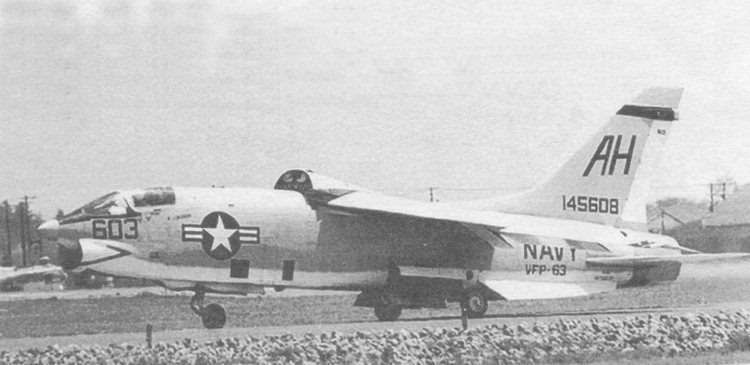
USN Vought RF-8 Crusader before take-off
Eugenie Vladimirov: On October 27, I have
arrived to take up duty post, and witnessed the following picture: Cubans
from the command post left out to the street, swinging the Granma newspaper
excitedly, and everyone tried to show his pleasure - our armies have brought
down an American plane. The plane fell down to the island, the pilot was
dead. In some days, an American plane arrived to take the dead pilot home.
The newspapers carried the picture: a coffin with a body of the pilot was
brought by gangway to the plane by six persons. The caption under the photo
said: “Pilot of the American Air Force major Anderson, married with three
children”. The reconnaissance plane U-2 could be brought down earlier by a
command “from above" to do it.
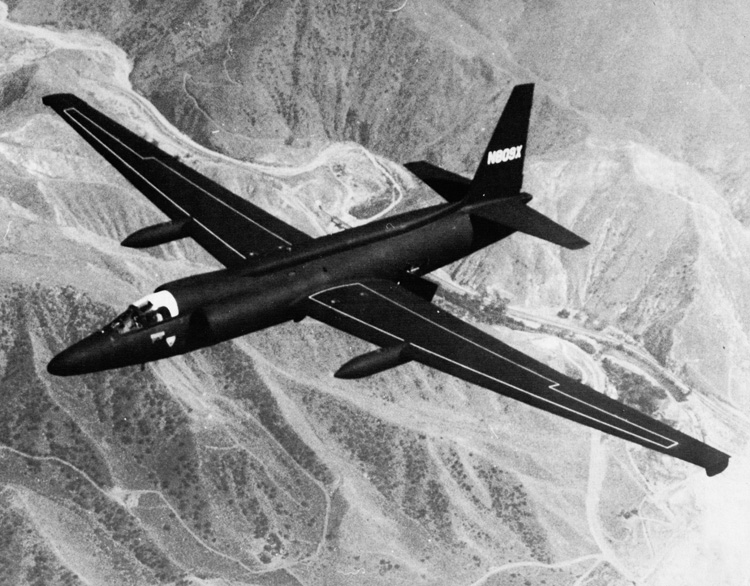
CIA Lockheed U-2 in flight
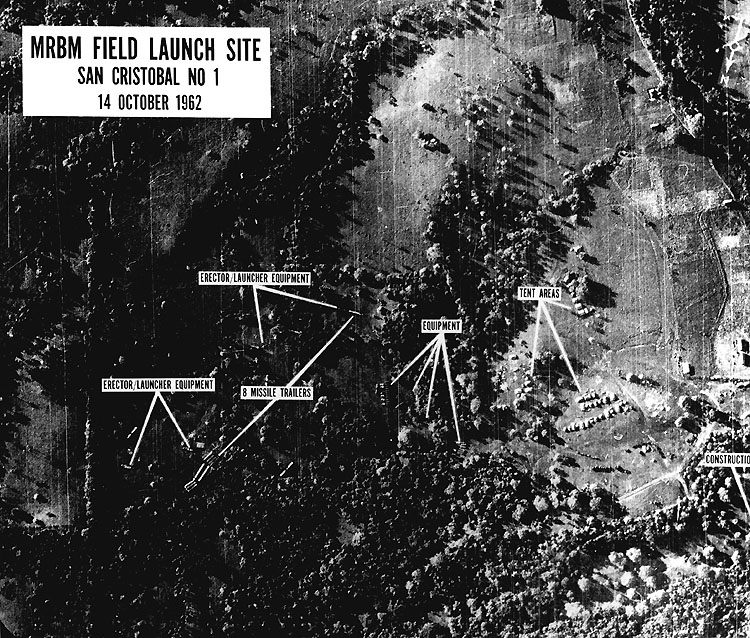
Photo of the Soviet ballistic missiles site
in San Cristobal, Cuba, made by Lockheed U-2 plane.
October 14, 1962. The John F. Kennedy Presidential Library
and Museum
Mikhail Isaev: Certainly, we could not
know all details in those October days of 1962. The intensity and alarm were
soaring in the air and were felt as some material force. We needed the
information badly. Instead, there were rumors. There was no panic, no
confusion. The mood was disturbing; all were oppressed with the
unpredictable near future. The faces of soldiers got serious and
concentrated. Even the known funnymen got silent. The discipline was highly
exclusive. The warrant-officers who evaded until that moment from receiving
the AK ("Kalashnikov") automatic rifles referring to the PM (“Makarov”)
pistols they had already got, demanded to replace the pistols with
“Kalashnikov” rifles as soon as they heard about preparations of the
American landing to Cuba.
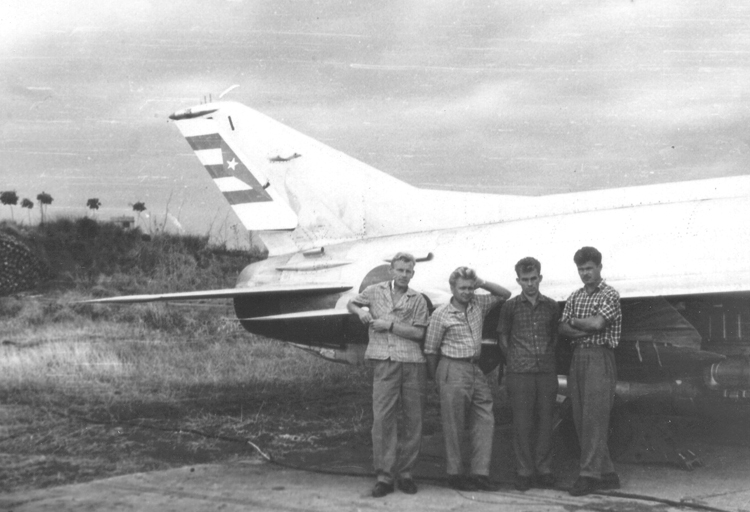
A flight on duty. From left to right: 32nd
GIAP pilots Kuganok, Vasiliev, Sergeev, and Bobkov.
San-Antonio AFB, November 1962. Leonid Kuganok’s archive
Nikolay Pakhomov: In these extremely
intense October days of the Caribbean crisis 1962, encrypted messages
arrived from the Group of the Soviet Armed Forces in Cuba headquarters
almost daily. The command informed us that the US Armed Forces were ready to
start bombing, and subsequently nuclear attacks across Cuba, and demanded to
take corresponding measures. We understood that we had nothing at the air
base to really protect the personnel and combat equipment. It was
practically impossible to provide shelters in the super hard ground with our
own hands; therefore, we had to expect the best possible outcome, a peaceful
resolution of the conflict. Commander of the regiment has decided not to
inform the personnel about the incoming messages to prevent pumping up of
the personnel feelings, the people were in the intense mood.
The USAF tactical fighters F-100 and F-101
appeared in the sky above Cuba regularly from 10.00 a.m. to 11.00 a.m.
carrying out reconnaissance missions. These reconnaissance flights went
unpunished until October 27 when a Soviet anti-aircraft missile brought down
U-2 aircraft. We were ordered not to open fire when meeting the American
planes.
Dmitry Bobrov: On November 4, 1962, our
squadron carried out training flights. After the task for interception of a
training target was accomplished, I approached the air base decreasing the
height before the landing. At this moment, I received a radio command from
Lieutenant colonel Perovsky, Flights Control Officer at that day: “Do you
see two Americans approaching the base on the landing course at the height
of 200 m?” Having looked round, I have seen a "foe" pair at the range of
about 1500 m, and answered “Affirmative!” Perovsky gave an order “Attack!
Frighten them”, – he added. I increased speed, came quickly closer to the
two F-101 Wodoo fighters and turned at a distance of 500-700 m just above
the air base that would allow launching missiles. The American pilots found
out pursuit behind them, boosted and started carrying out vigorous, with
black smokes, antimissile maneuvers (turn-away to the left - to the right),
and at maximum speed went to the sea, to Florida. My task has been executed,
and later scouts stopped passing the space above our air base. For the sake
of justice, I should say that sortie was carried out with a training missile
suspended, but the radar-tracking sight was on and the F-101s consequently
could find out the pursuit.
Many years have passed, and now I can
easily tell about that event, but now I got the order to attack the American
fighters, through detection and rapprochements, I felt an enormous pressure
and the responsibility, though I knew that it was a game. Since my plane
carried training missiles, and my 30-mm gun was not charged.
Mikhail Isaev: Next day after Major Dmitry
Bobrov had played an "attack" on the American fighters, Cuban comrades
retold us an American radio broadcasting which informed in Spanish “the US
Air Force aircraft have been attacked by unidentified air pirates in the
space above the island of Cuba”. That statement made by “Voice of America”
resulted in an urgent task that involved all hands. The order was quick:
paint the Cuban ID symbols on all MiG-21 planes (the “Voice” was right in
this respect since we had carried our missions with no ID on the planes).
All aircraft of the regiment got the blue-white-red signs of Cuba overnight.
A similar story happened to Major Shtoda,
commander of the 1st air squadron, one of those days. While en route from
Camague air base to Santa Clara, he met two American aircraft appearing in a
hemisphere behind them. As soon as they noticed a single MiG at the back,
the Americans retreated quickly from the air space of Cuba.
Our families retold us the story heard in
Russian over the “Voice of America” almost a year later when we returned to
our native Kubinka. They secretly listened to the American radio
broadcasting in Russian and passed the received information to their
friends. That was the only way they had found out that people of our
regiment were alive at least.
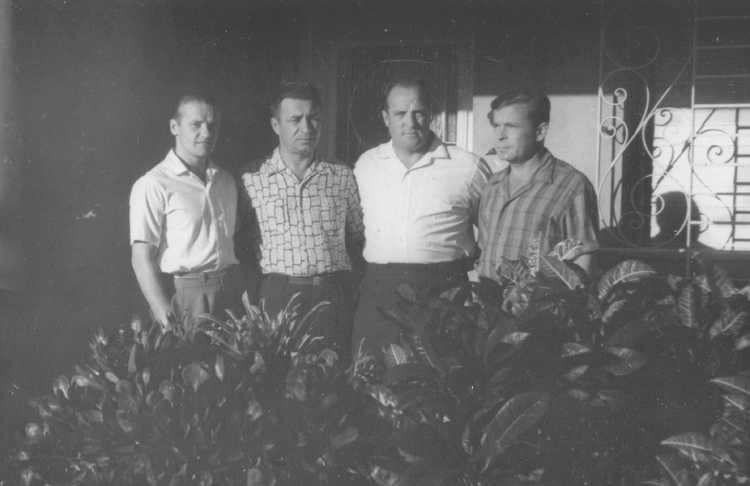
32nd GIAP’s top officers, from left to right:
the heard of reconnaissance major Dmitry Bobrov,
the deputy commander lieutenant-colonel Leonid Grigoryev,
head of the regiment’s political department
lieutenant-colonel Nikolay Shcherbina, the deputy commander
lieutenant-colonel Vladimir Grol. Cuba, 1963. Dmitry
Bobrov’s archive
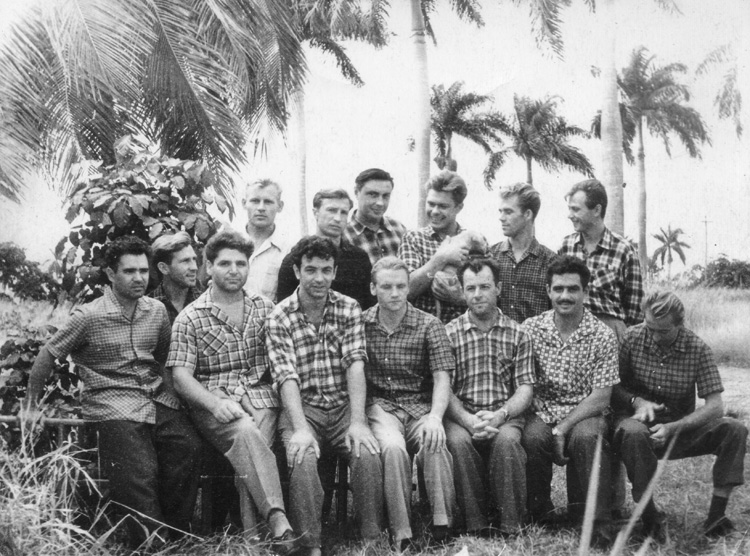
The 32nd GIAP the 2nd aviation squadron
pilots. Sitting from left to right: Minullin, Romasev,
Moeseev, Gerasimov, Bobrov, Eleseev, Tikhonov, Selyak;
staying from left ro right: Kuganok, Fadeev, Beloborodov,
Bobkov, Sergeev, and Rashidov. San-Antonio AFB, November
1962. Leonid Kuganok’s archive
Victor Sharkov: Our MiG-21s were in
alertness with a full unit of fire loaded. Once, after the flights were
over, we checked radio, electric and oxygen equipment as routine procedure.
A weapons mechanic, a soldier, unaccompanied by an officer, while checking
the equipment in the cabin, pressed the launching button of UB-16 unguided
rockets. Several rockets launched. One of them, with its tail unit, broke
off a side of lieutenant Pyatnitsa, an air technician, who stood at this
moment at the left UB-16 unit. The rockets then went over the runway and
blew up a wheel of a vehicle. A number of persons got small-scale wounds. It
was a clear violation of the Manual on aviation engineering service, which
said precisely that all checks must be carried out with the arms removed.
Lieutenant Pyatnitsa recovered and returned to his unit soon. The incident
was reported to army general Pliev. The witnesses said that the valiant
general cavalryman announced an order: “Adhere rockets and fire the
commander!”
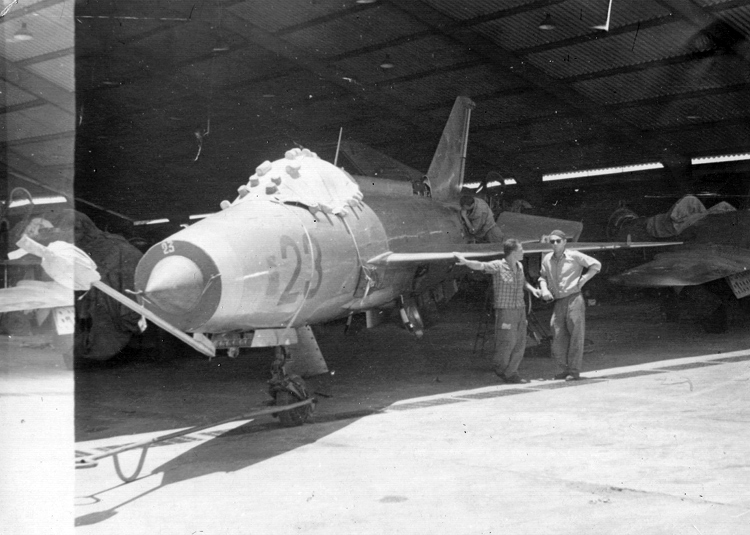
The 2nd aviation squadron’s MiG-21F-13
aircraft. From left to right: technician
1-st lieutenant Mokhnach, chief technician captain Sharkov.
San-Antonio AFB, 1963. Victor Sharkov’s archive
The 32nd Guards (213th) IAP, the only
MiG-21 regiment in Cuba, was some times visited by Fidel Castro, his brother
Raul Castro, and by other Cuban leaders who were vividly interested in the
newest Soviet aviation equipment, and had meetings with the personnel.
Vladimir Vasilyev: I took up combat duty
with my partner captain Alexander Markov. The duty planes were placed at the
starting command post (SCP); technicians were doing their work near the
aircraft. One could see the whole air base through big window from on the
second floor of the SCP. Suddenly a green big car appeared moving from the
dead area of the air base. Neither Cubans nor we did use that path. The car
was moving along the taxi runway directly to the SCP and after a while, it
pulled up at the entrance door. I carried on standing up on the second floor
and thinking whom they might be. Two doors of the car opened at once. A
"beard" got out from behind one door. My God, it was Fidel! Moreover,
following him were three good fellows - bearded men, each bearing two
enormous holsters with pistols attached to the belts, and automatic rifles
in the arms. Meantime, the vehicle of captain Prendez, chief of the AFB,
arrived from the side of the garrison positions. Figuratively speaking, I
was blown off from the second floor – a must is to report to the head of the
state!
It so happened that captain Prendez was
moving towards Fidel Castro from one side, and I – from the other one. I
remember that I mumbled something like “Comrade Fidel Castro! Here is
commander of duty pair captain Vasilyev”. With the eyes peeping at me, Fidel
stretched his hand to Prendez, and then shook hands with me. The situation
was seemingly managed. Chief of the air base got there in time since he knew
Russian and could translate. Fidel Castro moved then to the aircraft, the
technicians pulled off covers from canopies quickly. Fidel asked me
something and I could not understand it. Prendez rendered help with the
translation. There, Fidel was interested in the measurements of our
fighters. Then Fidel Castro wanted to see the cabin. We moved off the
canopy, checked the catapult safety locks, and seated him smoking a cigar.
With Prendez’ help the cigar was taken away. Having carefully examined the
cabin Fidel hemmed approvingly and asked someone with a camera to take
picture of him near the aircraft. Prendez disapproved of the idea.
Regretfully, Fidel waved his hand as if postponing it until some other got
into the car and left.
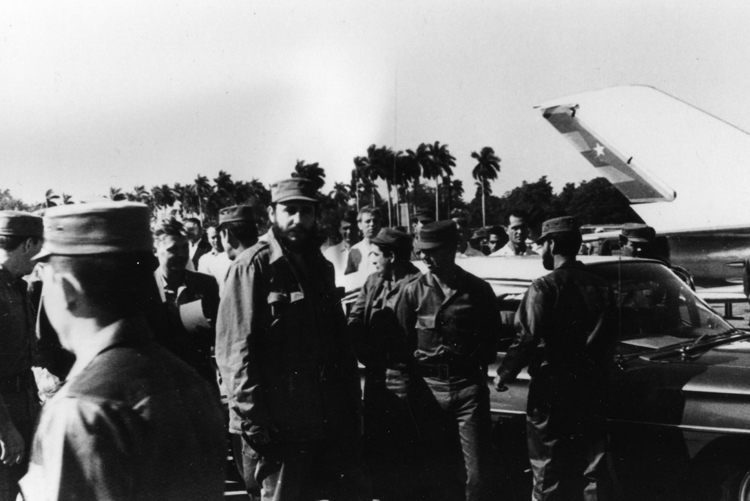
Cuban leader Fidel Castro on a background of
a 32nd GIAP’s MiG-21. San-Antonio AFB, April, 1963. Photo by
Mikhail Isaev
Victor Sharkov. From private diary:
December 25, 1963. Soldiers undergo all misfortunes courageously, live in
barracks, their meal was worse than ours. But they carry out their military
duty irreproachably. A big trouble was there with the soldiers to be
demobilized, their three-year service had been over but they were still
there in Cuba. Nobody knew what was going on or could tell when they would
come back home. These soldiers asked many questions on the subject but got
no answers, and behaved accordingly. For example, they refused to go for a
lunch or dinner went out to work reluctantly. We tried to talk them out of
the mood and disobedience, reported their behavior even to the commanders.
Some repressive measures were taken, some of them were put in a guardroom,
but it was not the way out.
Each of three squadrons of the regiment
was on combat duty a week. From 7.00 a.m. until it was dark. Four MiG-21 in
every squadron were ready for immediate take-off. The pilots remain in
high-level readiness, i.e. sitting in cabins of their planes.
The Americans made their flights over
Santa Clara air base regularly. Daily, to be precise, at 3.00 p.m., at low
speed, 30 to 50 meters above, strictly along the middle of the runway.
Impudently, with reliance, a pilot, chuckling, waved his hand, and we were
staring at his face in perplexity: the antiaircraft guns of Cubans were
nearby and silent, our duty aircraft likewise. Why after all did we suffer
all the tortures resulted from preparations of our planes and our presence
there?
Mikhail Isaev: Another mass defect of our
equipment was revealed at this time. Under the burning tropical sun the
canopy safety glasses began losing its transparency and bursting. Despite
all reasonable efforts and shifts of our technical personnel, the process
seemed irreversible. Therefore we received by air new glasses from the
Soviet Union for all the planes.
Knowing today the chronology of the
Caribbean crisis, one can tell that after our missiles were removed from
Cuba in December 1962, the threat of an American intrusion on the island
went down considerably, and the crisis was solved peacefully. Therefore, the
end of 1962 shifted our basic occupation from combat readiness to routine
training missions. Small panel board houses delivered from the Soviet Union
were under construction, paths were graveled, etc. With improved meals and
regular mail deliveries, our life looked more civilized. Moreover, tours to
the city and its shops were organized. To tell the truth, with our beggarly
cash we had nothing to do where special cards of limited supply were the
only currency to buy something. Once we even visited cockfights. Generally
speaking, we had more forbidding rules than those allowing - single tours to
restaurants, bars and other institutions were restricted.
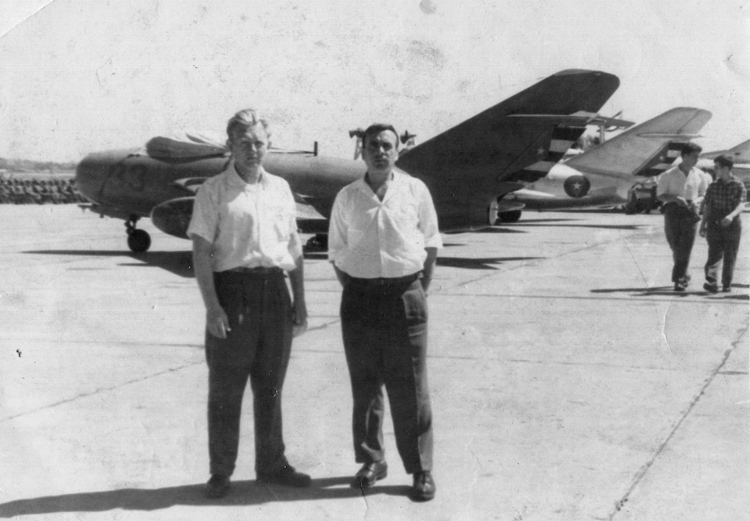
From left to right: technician 1-st
lieutenant Nazarov, chief technician captain Sharkov on a
background of Cuban MiG-17.
San-Antonio AFB, 1963. Victor Sharkov’s archive
Dmitry Bobrov: At the end of December
1962, the regiment was assigned a task to participate together with Cuban
pilots in an air parade to take place on January 2, 1963, the day of Cuban
Revolution celebrations. Our regiment allotted three MiG-21 to close the air
parade flying after the Cuban planes (MiG-17 and MiG-19) while passing
extremely low (100-150 м) above the main square of Havana and immediately
after that to climb attitude with full trust of engines. Our team was
determined as follows: the leader – Lieutenant-colonel Grol, senior
navigator of the regiment, the left-side pilot - Major Yeliseyev, commander
of the 2nd squadron, on the right side – me, Major Bobrov. Responsible
preparations began to develop synchronous flying within the dense flight
order called wing-to-wing. Besides, we were working out the task to join the
Cuban column in the right place and at the right time. Our task was, that by
the moment of the pass above the area where the Cuban leaders and thousands
of Cubans were settled, we had to shift to boosting and fly, literally
speaking, above "the tails" of the MiG-19 column at over 1000 km/hr and
upwards. Therefore, everyone was ready to.
In the evening and at night prior to the
parade, i.e. on January 1 1963, all San Antonio air base staff celebrated
New Year. Till late night there was a shooting all around from all kinds of
small weapons; the bullets were piping all round us, and loud appeals and
slogans cried out with the Cuban pathos flew out from numerous speakers
established everywhere around the small city. And we, participants of the
parade, had to have real rest and to sleep with all that noise around.
Nevertheless, we fulfilled our task perfectly, and I remembered the turning
point of the flight when at some moment I saw medley, dinky masses of people
merry-making in the main square of Havana.
Victor Sharkov. From private diary:
January 1, 1963 we celebrated the New Year twice - first it was the Russian
New Year, at 4 p.m. We raised glasses to those in Russia who looked our way;
we looked eastward and had a drink for 1963, and for those in the Native
land. Then we celebrated the local New Year with Cubans. Commander of the
regiment Shibanov and chief of political department Scherbina congratulated
us. At 5.00 a.m. I gathered the group who were taking over duties,
instructed them and checked up the flight’s readiness.
January 2. The parade in Havana was over; Cubans celebrated the Day of
Revolution. And the regiment was on alert until 2 p.m. to prevent any
surprises.
January 3. It was “awfully cold” at night - +7С. The flight on duty settled
down near the Cuban antiaircraft gun. We were wearing shirts and flight
jackets. However, the Cuban guards muffled in blankets were looking like
scarecrows.
January 7. Today the Soviet cosmonaut #4, Pavel Popovich, who had been a
pilot in Kubinka, arrived to visit our regiment. Popovich who had left us as
the first lieutenant in 1959 was lieutenant colonel by the time. He went
into details about preparations for his space flight, the flight itself and
his landing. He told us at the end: "I know that you are here in a situation
that is not easier than ours in space". These words caused furor then, all
stood up and applauded ardently. He looked that day more solid than in 1959.
His speech was simple and good-natured, quirked a little bit. Our general
impression was good. The banquet was later good, too.
January 13. Sunday. I stopped on purpose by Cuban barracks. All was order
and cleanliness. Inside there were a guard-detail and a number of persons
punished that week. The other military persons left at 5 p.m. on Friday for
their homes all around Cuba. They would come back to the barracks on Sunday
no later that 12 p.m.
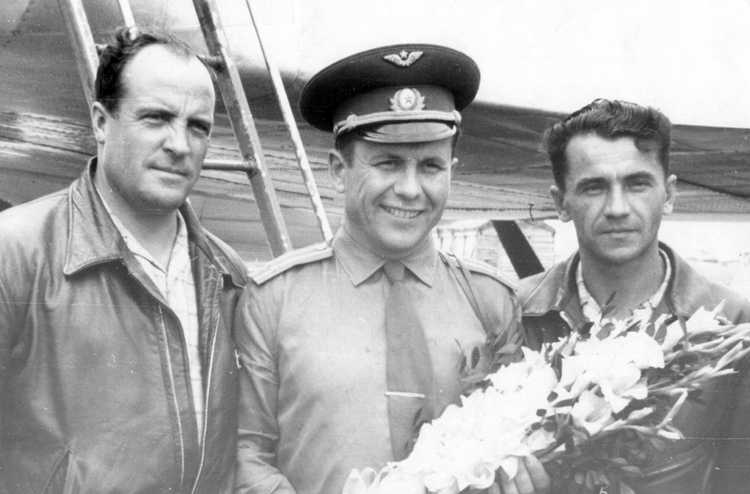
From left to right: head of the regiment’s
political department lieutenant colonel Nikolay Shcherbina,
the Soviet cosmonaut # 4
Pavel Popovich, the regiment commander colonel Nikolay
Shibanov. Santa-Clara AFB, January 7. 1963. Nikolay
Shibanov’s archive
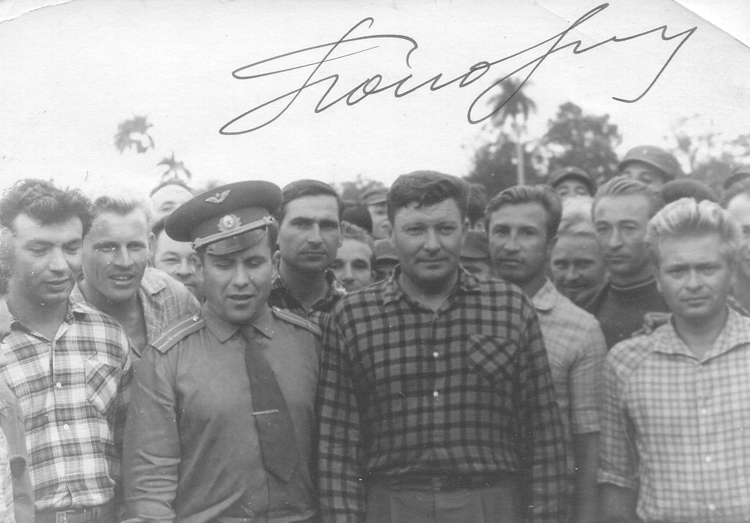
Cosmonaut Pave Popov and the 32nd GIAP
pilots. From left to right: Gerasimov, Kuganok, Popovich,
Markov, Perovsky, Fadeev,
Selyak, Vasiliev. At the top of a photo cosmonaut Popovich’s
autograph. Santa-Clara AFB, January 7, 1963. Leonid
Kuganok’s archive
RE-TRAINING
Nikolay Pakhomov: After the Caribbean
crisis had been settled peacefully the decision was taken to train Cuban
pilots to master MiG-21F-13 and then transfer the aircraft and serving
technical equipment of our regiment to the Cuban Air Force. It was thus
stipulated that one squadron of the regiment would be assigned for the
purpose, including pilots, engineers, technicians and service personnel.
On February 18, 1963, our regiment got an
order to concentrate at San Antonio AFB. Soon Cuban pilots and technical
personnel started theoretical studies of MiG-21F-13 and its Tumansky R 11
engine. Our regiment defined a group of pilots-instructors headed by
lieutenant colonel Grol, deputy commander of the regiment. All Cubans pilots
were divided into two groups. The first one comprised skilled pilots -
lieutenants who had mastered MiG-19P aircraft, the second - ordinary pilots
who got scant flight experience with jet planes. Then they came over to
practical flights. Lieutenant colonel Grol held an interview with everyone
in the plane, and then made a circle flight on UTI MiG-15 trainer to be
convinced of readiness of pilots to make the first solo sortie on supersonic
MiG-21. The sorties were a success, with no breakages or failures happened.
Within April 1963, 22 Cuban pilots were
retrained to fly MiG-21F-13 from the first trainee group and eight - from
the second one. On April 12, the first Cuban pilot made his first solo
sortie by MiG-21. All pilots were mastering piloting, pattern flights,
interceptions at medium and high levels, and in a stratosphere, executed
shooting at ground targets from guns and by rockets. The program resulted in
29 pilots prepared for single combat missions under day simple
meteorological conditions at all heights, and 26 pilots to operate in pairs.
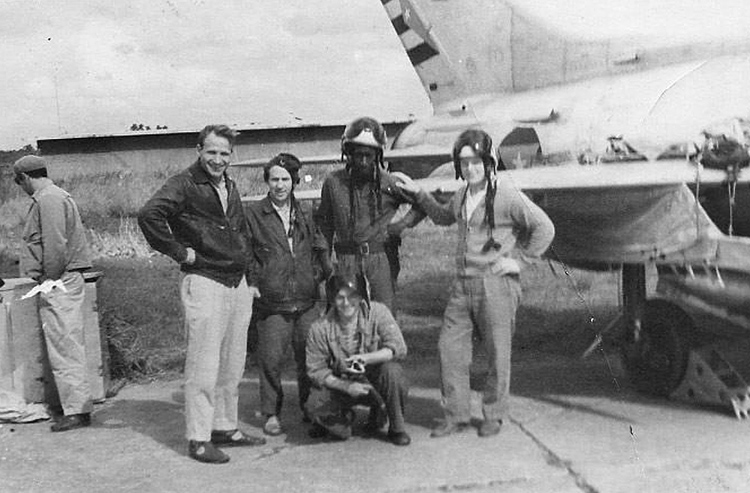
The Soviet and Cuban aviators. The second
from left – pilot Rumyantsev. Cuba, 1963. Nikolay
Rumyantsev’s archive
Michael Isaev: The air base of San Antonio
was determined a place to organize a retraining center for flying and ground
engineer personnel. It was the largest air station on the island with three
3-km long concrete harp flight strips, and advanced infrastructure.
The retraining was carried on gradually.
Retraining draft programs were developed first, groups of teachers were then
determined, and educational and visual stuff was prepared. The would be
teachers were assigned individual tasks on profound teaching on MiG-21F-13,
on engine R-11, as well as on systems and equipment. As soon as in February
1963 we got an order to retrain Cubans pilots, our regiment went on making
sorties just to maintain the necessary level of mastership, and the basic
efforts of the regiment was aimed at retraining Cuban personnel. So we
turned to teachers and instructors.
As the Soviet command had recommended, the
Cuban AF command selected the most skilled pilots and engineers to be
retrained, including those who had been already trained in the USSR,
Czechoslovakia, and China. The retraining process of the Cuban ground
technical personal was organized at the regiment maintenance unit (in
Russian called TECH) where the most skilled experts with wide experience and
the necessary instrumentation were concentrated.
The Cuban air engineering service was
organized similarly to that of ours. I was assigned head of the joint
Soviet-Cuban group of radio experts. Cubans were attached to every Soviet
mechanic and technician. Among Cubans there were experts who had already
been trained in socialist countries. My Cuban colleague Eduardo Martinez
underwent retraining in Czechoslovakia and technician Jimeli studied in the
Soviet Union and spoke Russian well. Eduardo began learning Russian when we
arrived to Cuba, and by the time the retraining process started, we needed
no translator to communicate.
To facilitate theoretical studies, each
trainee group got translators who arrived from the Soviet Union for the
purpose. However, the very first lesson revealed that the Soviet translator
had no knowledge of aviation and technical terminology and his translation
was quite inadequate. Martinez and Jimeli gave their helping hands.
Therefore, they listened to my Russian explanation of technical devices,
specified nuances or details, wrote down every detail, and then retold it to
colleagues in Spanish. Theoretical studies were secured with practical
servicing of technical equipment where the main training principle was the
army motto “do as I do”. The retraining studies were over after the Cuban
experts passed exams, and certificates were signed to testify their
qualifications as independent servicemen for MiG-21F-13 aircraft. By summer
of 1963, the retraining of Cubans was completed with no incident or
precondition impending.
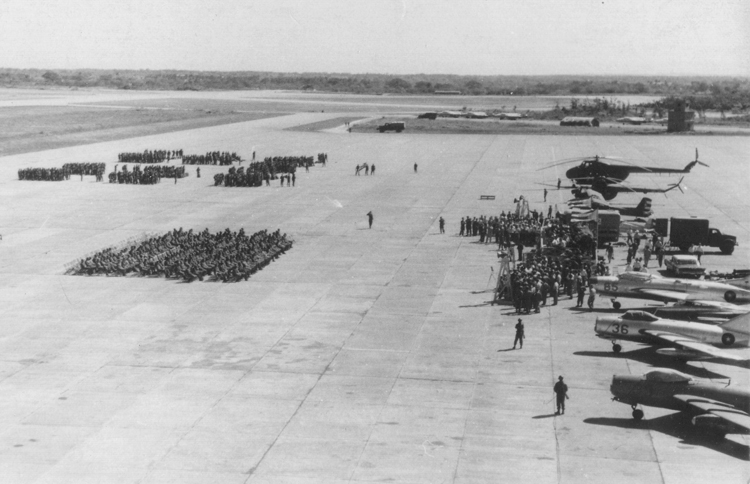
San-Antonio AFB. April 17, 1963. Photo by
Victor Sharkov
Nikolay Pakhomov: April 17, 1963 will be
remembered well. Both Cuban and Soviet air units at San Antonio AFB
celebrated the Day of aviation of the Revolutionary Armed Forces of Cuba. At
9.00 a.m. Fidel Castro, Raul Castro, Curbelo, commander of the Air Force of
Cuba and other officials arrived to the base. A ground parade of military
units opened the ceremony, and then major Prendez, commander of the base,
announced an order promoting about 300 persons to commissioned officer
ranks. A speech was delivered by a representative of the Group of the Soviet
armed forces, by commander of the Air Force of Cuba; Fidel Castro who spoke
about an hour summarized the celebration.
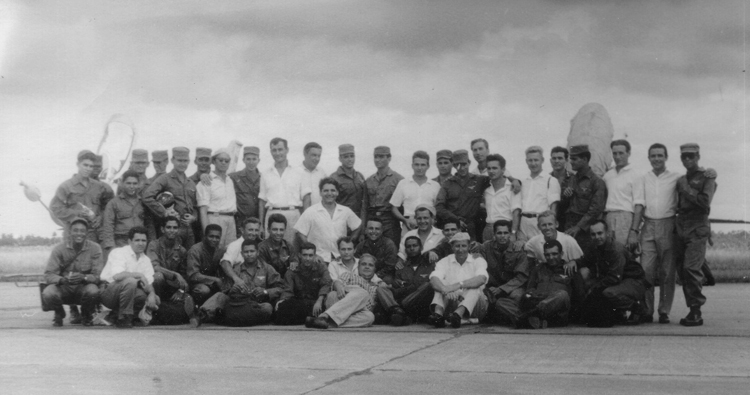
The Soviet and Cuban aviators. San-Antonio
AFB, summer 1963. Leonid Kuganok’s archive
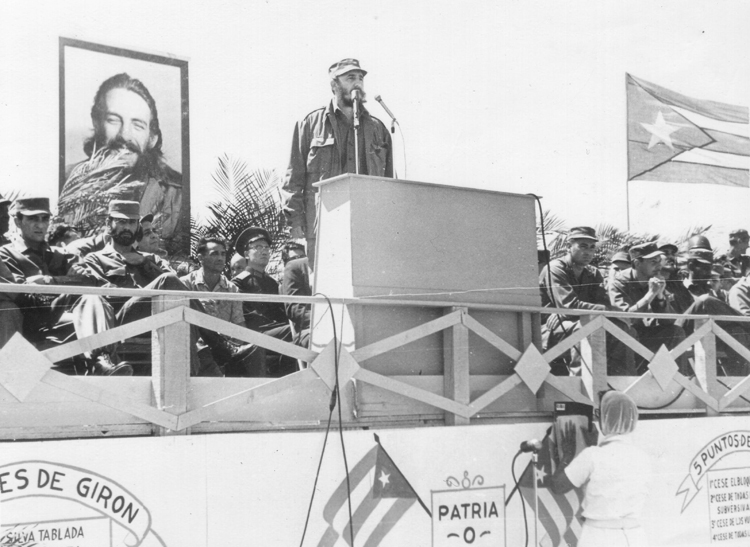
Fidel Castro is making speech. San-Antonio
AFB, April 17, 1963. Photo by Mikhail Isaev
Michael Isaev: The lieutenant military
insignia were handed over by Fidel and Raul Castro. At this moment, I pulled
out my FED photo camera and started shooting. I managed to come close to
young Cubans Fidel handed over the officer stars to. While focusing the
camera, I saw Fidel's eyes and was struck with witticism and depth of his
black piercing eyes. I had an impression as if an electric charge had run
through me. With the ceremony over, a Soviet soldier Vasily from our
regiment told his Cuban colleague that he wanted to be photographed together
with Fidel. After a short talk to Fidel Castro the Cuban colleague came back
has said: "Vasily, bamos (follow me)." I keep this picture of Russian
soldier Vasily Bratusev taken together with Fidel in my family album.
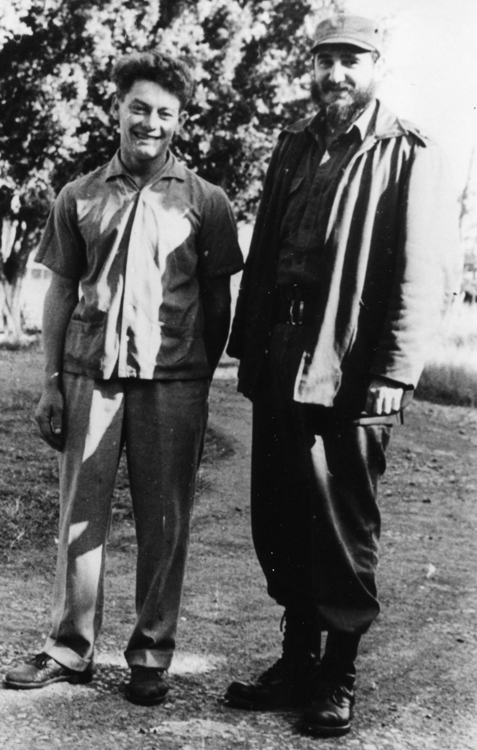
Fidel Castro and the 32nd GIAP soldier Vasily Bratusev.
San-Antonio AFB, April 17, 1963. Photo by Mikhail Isaev
Nikolay Pakhomov: After the speech Fidel
had delivered, we saw an air performance made on MiG-19 aircraft by Cuban
pilot captain Pino, a low flight of MiG-19 above the ground, then aerial
stunt above the air base on MiG-21 demonstrated by lieutenant colonel
Scherbina, chief of political department of the regiment. Summarizing the
show, Major Carreros, deputy commander of the Air Force of Cuba made a boost
take-off and a maneuver above the air base on MiG-21. In the evening
commanders of our regiment were invited to a Havana party held at the Army
House of. There were no setouts of food or speeches, or toasts. Cubans and
we treated personally each other. The same evening there was a wedding of
three military couples. The newly married couples passed all over the hall
under the crossed rifles and to the stage where grown-ups congratulated
them. Then, a dressed groom embattled in the sea, thanks God it was nearby,
caused great amusement. Dances were non-stop. All was good.
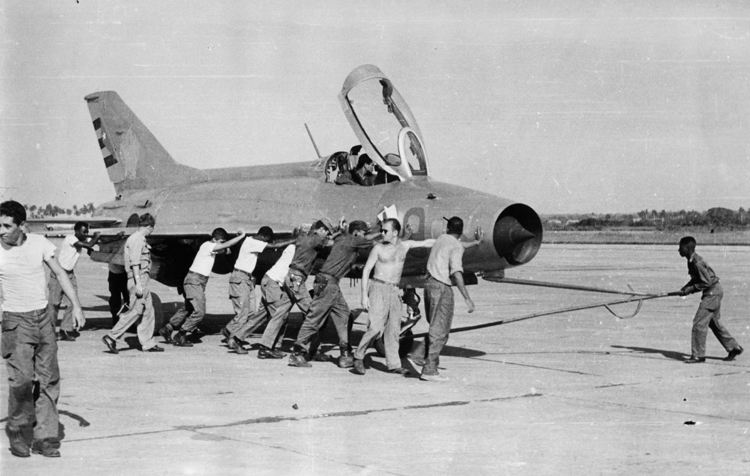
After a solo flight made by a Cuban pilot
ground personel’ is parking MiG-21F-13. San-Antonio AFB,
1963. Leonid Kuganok’s archive
Victor Sharkov: Though we worked much, but
sometimes we had time to rest too. Once on a day-off we were walking in
Santa Clara, taking pictures looked in bars to have a drink or two. Barmen
over there were affable, treated us sometimes at their own expense. We were
juiced all right, but hungry, and left for a bus stop, bent and tired. All
of a sudden all cheered up, we felt our native, Russian smell hardly
perceptible. In no way could we get where it had come from. We made a
hundred of steps and understood that it was the smell of a herring (we did
not get herring for six months) over streaming out of a shop. We approached
it. There was a chow line after goods payable by coupons. Inconvenient to
lose time in the line but worthy. “One moment”, Sasha Nazarov said, made his
way closer to the counter, while we were watching him from the entrance
door, and addressed the people: “Compañerawomen and compañeramen, may we
have please uno herring for a ruso team?” A burst of laughter followed, and
the seller stretched out a package of two herrings free of charge. We went
over the corner of the bar, broke off a herring in three parts and swallowed
them heartily. And thoughts about our Native land, which teemed for the
fish, came to our easy minds.
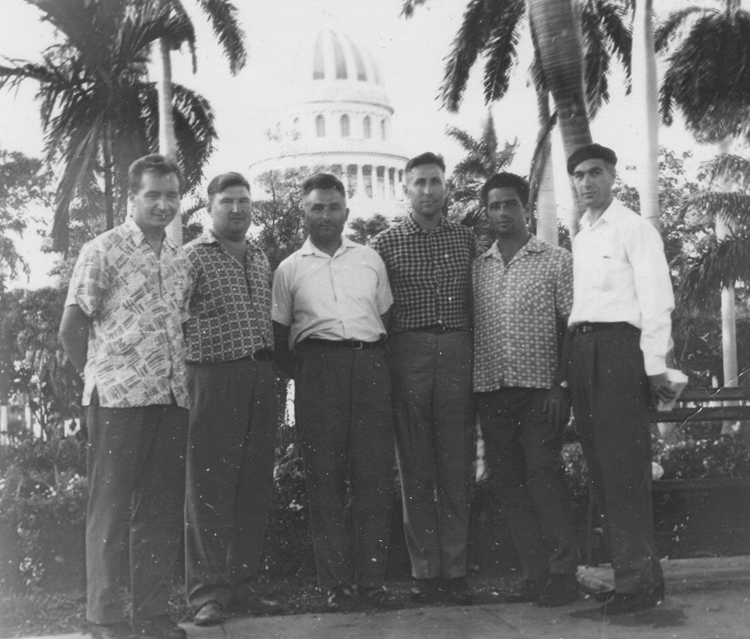
The 32nd GIAP officers at excursion in
Havana. From left to right: Tikhonov, Pakhomov, Sidorenko,
Sherstobitov, Kas’yanov, Isaev.
Havana, 1963. Mikhail Isaev’s archive
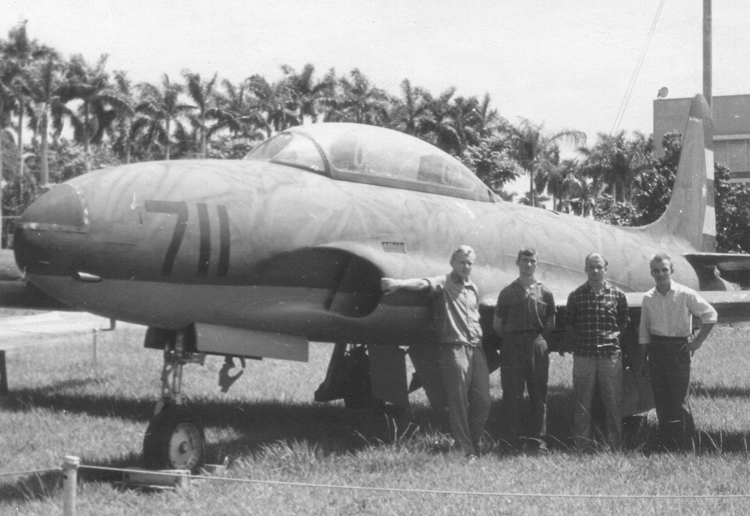
On a background of Lockheed T-33 two-seat
trainer belonged to Batista AF. The first from left – pilot
Leonid Kuganok,
the third from left – pilot Dmitry Bobrov. San-Antonio AFB,
summer 1963. Leonid Kuganok’s archive
Eugenie Vladimirov: Within the first years
after the Cuban revolution, each province of the country (Cuba was divided
into six provinces) was assigned a responsible person to be in charge of.
Therefore, Fidel Castro was in charge of the central province Las-Villas,
the main city - Santa Clara. There were many people, so-called “enemies” of
revolution - "contras". Really, we could quite often hear chaotic shooting
from automatic guns or rifle shots at night. As Cuban navigators told me,
Fidel treated the "contras" tolerantly, i.e. they should be worked with
ideologically and bring up these people to the understanding of the
revolution. Fidel’s brother - Raul Castro, Minister of defense, was
responsible for the province of Oriente, the main city - Santiago de Cuba.
Raul was a stickler of a relatively tough policy towards the “contras”. If
caught red-handed, the "contras" would be shot at once. Following the
stories told by Cuban navigators, Fidel Castro got information saying that
Raul had shot "contras" ruthlessly. Fidel sent a telegram to Raul saying:
"Brother, there was too much bleeding in your struggle against
counterrevolution, was it not?" The reply sent by Raul Castro said: "Good,
Brother, there will be no bleeding any more!" And he stopped shooting
"contras", and started gibbeting them.
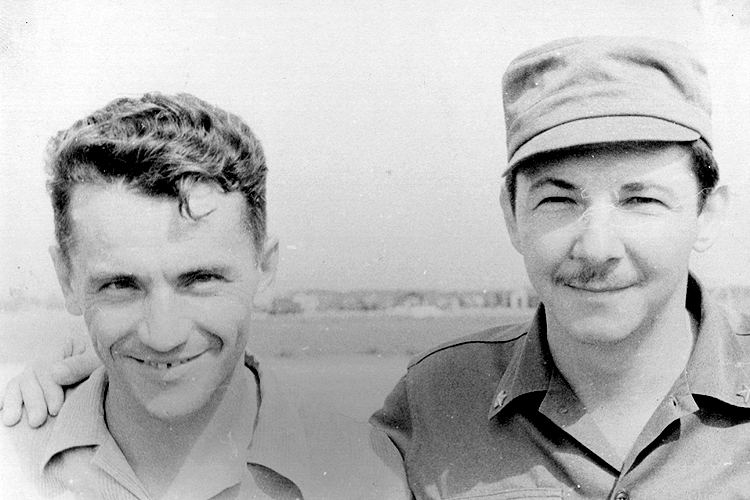
The 32nd GIAP CO colonel Nikolay Shibanov and
Raul Castro. Cuba, 1963. Nikolay Shibanov’s archive
Mikhail Isaev: Once in August of 1963,
when the working day was over, my colleagues and I decided to go swimming.
We arrived to the beach of Varadero, plunged into warm water, and then lying
on the beach sand we talked. All of a sudden, the Cubans who were lying
nearby jumped up shouting "Fidel, Fidel!" and ran away. We followed them.
The Cuban leader just went out of the sea. His bodyguard thrown a shirt to
him, which he could hardly shoulder with before the crowd surrounded him.
Cubans asked something, Fidel answered. A man with a kid on his hands stood
nearby. The kid reached out and touched Castro’ wet beard, which caused a
storm of delight of surrounding people. Fidel chucked the little boy and
left for a jeep. I looked around, another car was parked there, and three or
four gunners looked attentively sideways. No more guards were noticed.
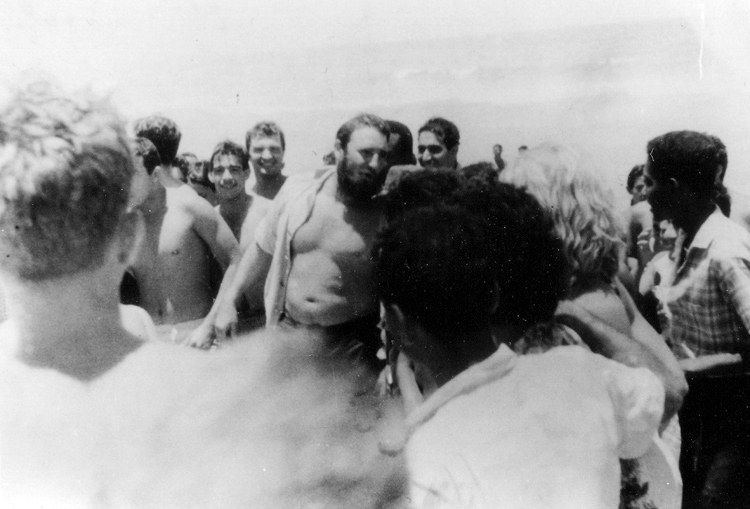
Fidel Castro on the beach, Varadero, August
1963. Photo by Mikhail Isaev
BACK HOME
Nikolay Pakhomov: On August 10, 1963
Colonel Shibanov, commander of the regiment, received the long-awaited order
to hand over our combat equipment by August 25 and be ready to leave for the
Soviet Union. We were waiting for the order over six months. The planes were
handed over to the Cuban side on August 20. Cuban minister Raul Castro
arrived to visit us at San Antonio AFB for the purpose. The MiG-21 aircraft,
technical equipment and the staff were grouped on a site near the
command-and-control center. General Grechko, deputy commander of the Group
of Soviet Armed Forces in Cuba, opened the solemn ceremony with an
introductory speech. Then commander of the regiment colonel Shibanov handed
over a memorable gift to Raul Castro - a traditional breadboard model of
MiG-21 aircraft made by Soviet skilled craftsmen. Then the Cuban military
and civil leaders inspected technical equipment. After the inspection,
MiG-19P and MiG-21F-13 piloted by Cubans flew low above the air base. Raul
Castro delivered the closing speech emphasizing that "Cubans would never
forget the brotherly help the Soviet soldiers - internationalists rendered
to them". The solemn act being over, technicians towed off MiG-21F-13
aircraft to parking space. On September 14, 1963, we waved goodbye to Cuba.
We gathered together in San Antonio base, checked the personal, went by
buses to the military port of Havana and after another check arranged by
"special units" were on a deck of cargo vessel "Yuri Gagarin". At 7 p.m., it
left for the port of Baltiysk. "Yuri Gagarin" carried mainly the ground and
technical personnel, as well as servicing units of the regiment. The flying
staff mainly returned to the Soviet Union by passenger planes of the Soviet
airline "Aeroflot", someone – by passenger steamships.
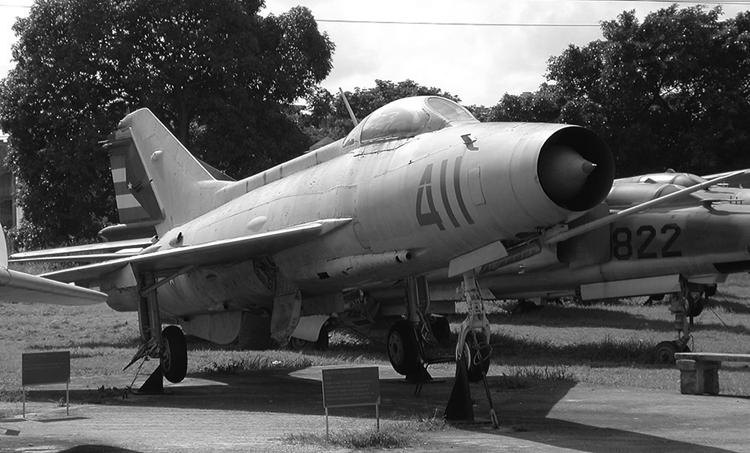
Cuban MiG-21F-13, Armed Forces Museum,
Havana. Probably this aircraft was belonged to the 32nd GIAP
in 1962-1963.
Photo by Jose Ramon Valero
Mikhail Isaev: We were returning home in
holds of cargo ship "Yuri Gagarin ". About 300 servicemen were placed in
each of four holds. Deck chairs were spread out in the holds to sleep in and
some big tables in the center to place food on. We called hold 2 "an
officer's wardroom" with our officers placed, and three other holds carried
soldiers. At the approach to Bay of Biscay, we got in a storm and found out
what the seasickness was about. After arrival in the port of Riga, we were
settled in barracks of local garrison to be in quarantine and to receive
some documents since in Cuba we had had no ID at all. Unfortunately, in Riga
I had to stay longer than my colleagues did. As chief of the maintenance
unit, I had to make out demobilization papers and send home soldiers. Only
on October 3, 1963 could I return to native Kubinka.
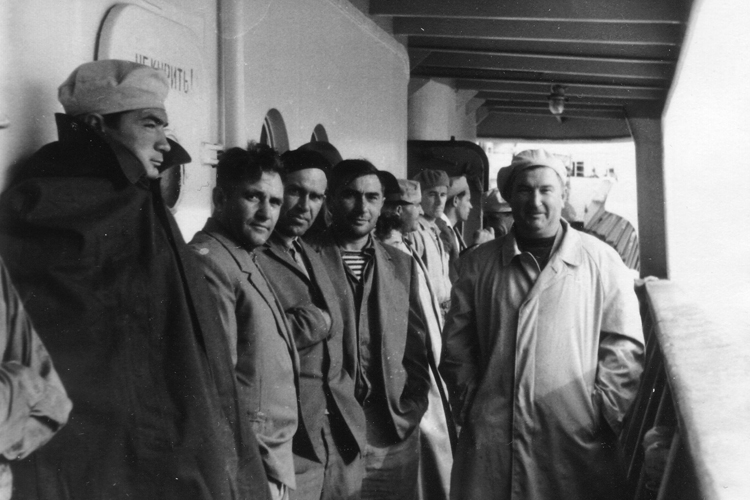
The 32nd GIAP officers onboard cargo ship
"Jury Gagarin " during return trip.
The Northern Sea, September 1963. Nikolay Pakhomov’s archive
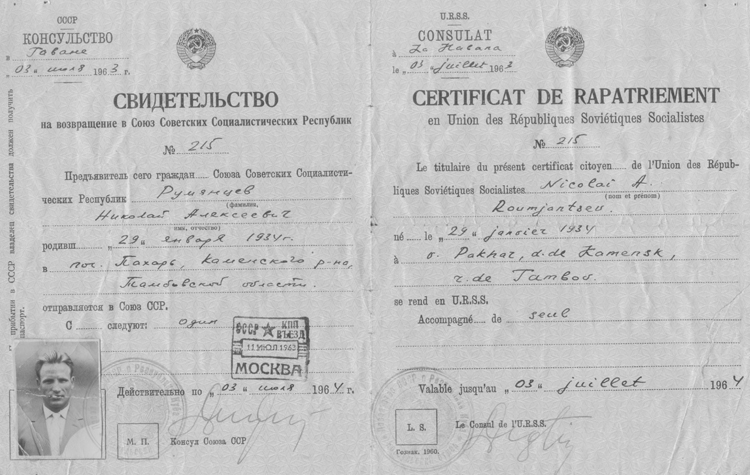
“The certificate for returning to the Soviet
Union” issued to the 32nd GIAP pilots Nikolay Rumyantsev
Nikolay Pakhomov: A group of the
regiment's personnel was awarded government awards for exemplary performance
of the mission. Commander of the regiment and chief of political department
got Lenin awards; the others received various awards and medals of the
Soviet Union "for excellent accomplishing the Government's task".
Victor Sharkov: In October 1963, after
returning from Cuba, our regiment that had been on “a special mission” as
213th AFR was disbanded, and the 32nd GAFR had been formally disbanded even
earlier, in September 1962. Our future service and life was ignored over
three months. Formally, the personnel of the regiment remained "beyond
manning table" and "on a holiday". In the long run, somewhere in high places
a decision was taken to restore the 32nd GAFR. On January 4, 1964, our
regiment was gathered for a solemn meeting at the garrison of Kubinka.
Solemn minutes! Deputy Commander of 9th AFD colonel Phillip Onoprienko who
had been commander of our regiment for five years read the order of Minister
of Defense stating to restore the 32nd GAFR and entrust the regiment with
the Guards Red banner. He handed over the Guards banner to a new commander
of the regiment - lieutenant colonel Leonid Grigoryev saying: "Grigoryev,
take the flag and commanding authorities!" Therefore, the Cuban epic of the
32nd Guards Vilensky Air Fighter Regiment awarded with Lenin and Kutuzov
orders came over. The regiment was ready to begin executing new missions.
Only 26 years later the veil of secrecy
was officially removed from "Anadyr" operation. Only on December 28, 1988
the decree of Presidium of the Supreme Soviet of the USSR had formally
admitted the presence of the Soviet troops in Cuba in 1962-63. By the order
of the Soviet Minister of Defense № 220 of June 5, 1990 a big group of
participants of Cuban events of 1962-63 were given a soldier –
internationalist rank "for courage and military valour shown while executing
an international mission”. Among the decorated persons were my father and
his fellows served with the 32nd Guards Air Fighter Regiment in Cuba. Better
later than never.
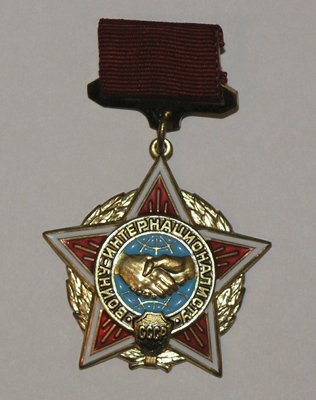
Breastplate ”Soldier-Internationalist”
|